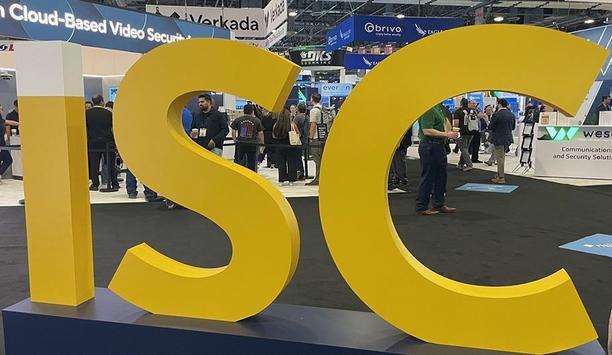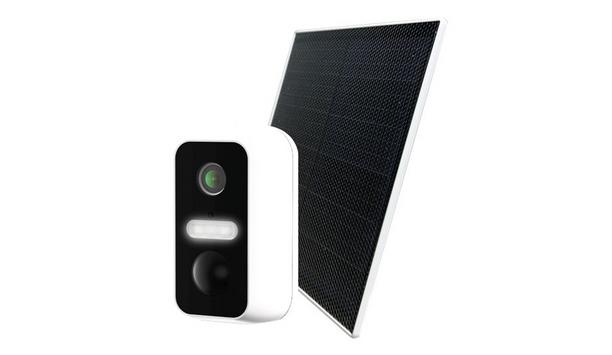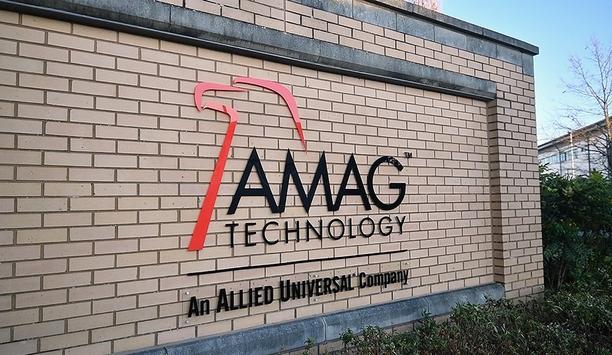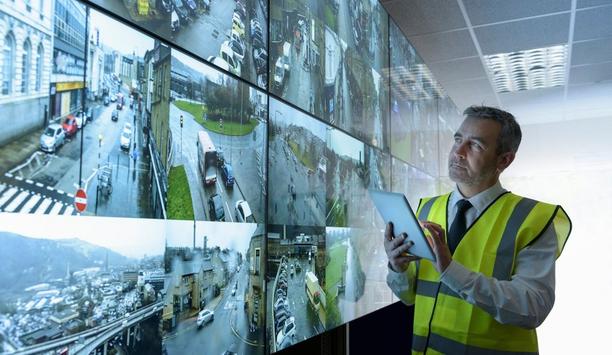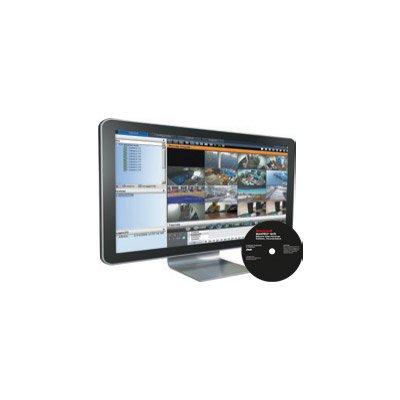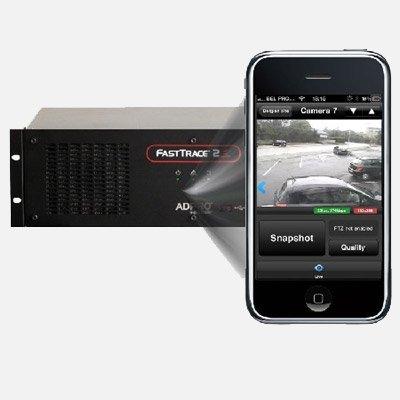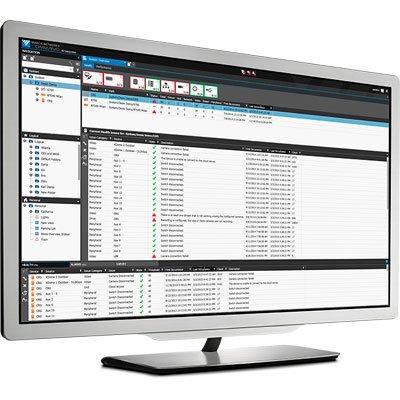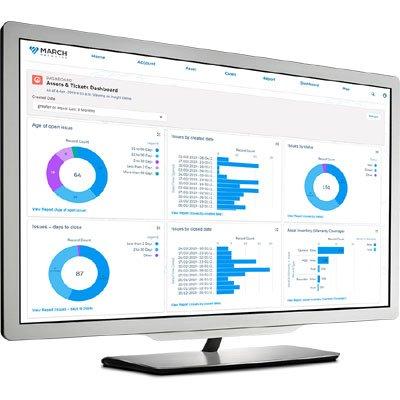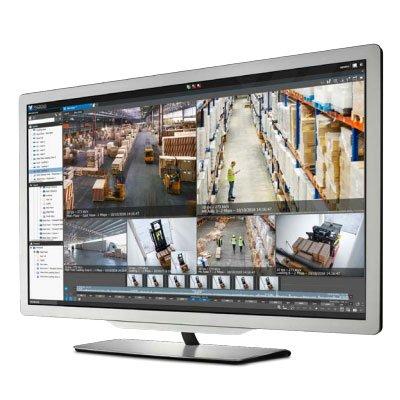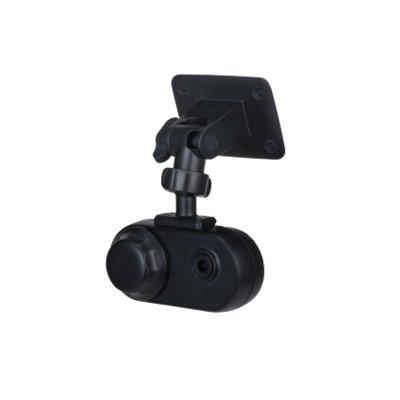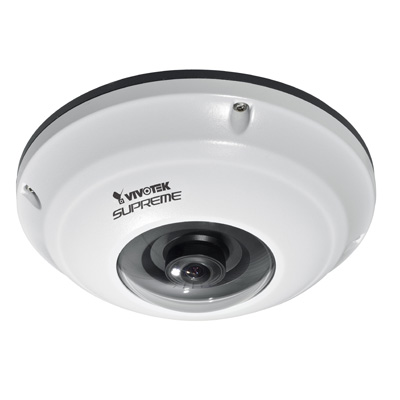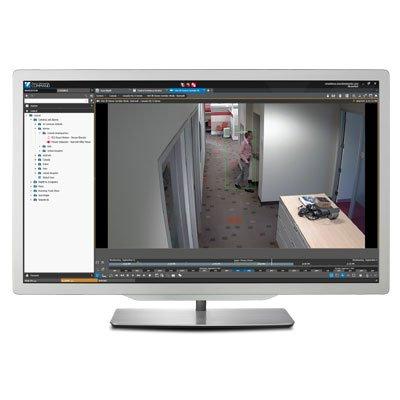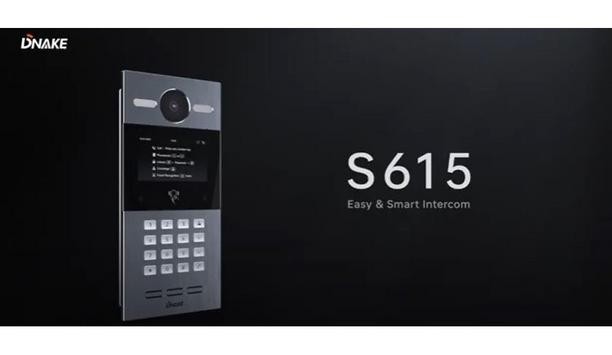Mobile surveillance
The Physical Security Interoperability Alliance (PSIA) hosted a well-attended cocktail reception and live demonstration during ISC West 2025 to unveil its latest advancement: the PKOC 3.0 specification, an exciting solution for secure, open credentialing in physical access control systems. Jason Ouellette, Chairman of the PSIA and Corporate VP of Innovation and Technical Partnerships at ELATEC, led the presentation. He shared an overview of PKOC’s progre...
ISC West 2025 in Las Vegas showcased the latest advancements in security technology, offering security professionals a glimpse into the future of the industry. This year's expo highlighted the growing influence of artificial intelligence (AI), cloud computing, and enhanced integration. The pioneering comprehensive and converged security event attracted nearly 29,000 industry professionals to the Venetian Convention Centre. Integration into unified platforms Several companies emphasised...
Robotic Assistance Devices, Inc. (RAD), a subsidiary of Artificial Intelligence Technology Solutions, Inc., announced the expansion of its popular RIO™ solar-powered, mobile security solution lineup. Named RIO Mini, the new security solution is now in production, with the Company forecasting that it can add up to 500 units to its sales expectations this fiscal year. Mobile surveillance systems The Company joins LiveView Technologies Inc., which raised $50 million in a Series B round in...
Umazi, a pioneer in digital identity verification solutions, has welcomed the latest report from CFIT, Fighting Economic Crime Through Digital Verification: The Case for Adopting a Digital Company ID in the UK. The report highlights the potential to revolutionise business operations in the UK by improving efficiency, security, and trust. Innovating business verification CFIT has convened over 70 pioneer organisations to design and develop the Digital Company ID—a unique digital represen...
Untether AI®, a pioneer in energy-centric AI inference acceleration, is teaming up with AI Platform Alliance members Ampere® Computing, NETINT, ZoneMinder, AVC Group, and ASA Computers to introduce the Intelligent Video Recording (IVR) solution at ISC West 2025, the premier security industry tradeshow. This groundbreaking AI-powered system sets a new benchmark in video surveillance, delivering up to 8x better AI camera efficiency while operating in an eco-friendly server cons...
Appdome, the pioneer in protecting mobile businesses, revealed it has been recognized as the market pioneer and high performer in four (4) additional categories for Spring 2025 on G2. The world’s largest and most trusted software marketplace. The four new pioneer categories include Bot Detection & Mitigation, No-Code Dev Platforms, Rapid App Development and Best Relationship for RASP. Standard in security Appdome strengthens its position in mobile app defence, building on its recogn...
News
The video door phone user chooses serves as the property's first line of communication, and its operating system (OS) is the backbone that supports all its features and functions. When it comes to selecting between Android and Linux-based systems, the decision can be crucial, affecting not just the initial cost but also the long-term performance and user satisfaction. To help users navigate this choice, DNAKE provides a detailed comparison between Android and Linux door phones. The Basics Android OS, developed by Google, has revolutionised the mobile industry with its user-friendly interface and extensive app ecosystem. Originating from a mobile-first approach, Android has evolved to power not just smartphones but also a range of devices, including video intercom. Its intuitive design and smartphone-like features make it a popular choice for those seeking a familiar and seamless user experience. Linux OS Linux offers a robust platform for developers, allowing for high customisation and integration Linux OS, on the other hand, is a powerful and versatile open-source operating system. Known for its stability, security, and flexibility, Linux has become a staple in server environments and is now making its way into the consumer market, including video door phone systems. Linux offers a robust platform for developers, allowing for high customisation and integration with various hardware and software components. Differences and strengths As Dnake delves deeper into the comparison of Android and Linux video door phones, it's important to understand the fundamental differences and strengths of these two operating systems. Both Android and Linux bring unique value propositions to the table, catering to different user needs and preferences. Android vs. Linux Door Phones: A detailed comparison 1. User Interface and Experience Android-based video door phones offer a familiar and intuitive user interface, similar to that of Android smartphones and tablets. This means that users can easily navigate the system, access features, and customise settings with minimal effort. The touchscreen interface provides a smooth and responsive experience, making it easy to view live video, communicate with visitors, and control other devices. Linux-based video door phones might not have the same level of visual polish as Android, but they offer a robust and functional user interface. Depending on the distribution, Linux door phones can provide a more traditional desktop-like experience or a touch-friendly interface. 2. Features and Functionality Android-based video door phones: These devices are not just about seeing who's at the door; they offer a multifaceted experience. With smart notifications, the user is always in the know, whether it's a package delivery or an unexpected visitor. Their seamless integration with other home automation systems means users can control more than just the door, all from one interface. Furthermore, the vast app ecosystem of Android provides access to a wide range of third-party apps and services that can enhance the functionality of the video door phone. Linux-based video door phones, being open-source, allow for a wide range of integrations, especially for tech-savvy users. While not as seamless as Android, Linux door phones still offer remote access and integration with other systems through various protocols and tools. They often find their place in more complex or customised smart home and building management systems. 3. Security and Privacy Security is a top priority for video door phones, as they serve as the frontline defense for the home. Both Android and Linux platforms offer robust security features to protect the system from unauthorised access and malicious attacks. Android video door phones benefit from Google's security measures, including regular updates and patches to address vulnerabilities. These devices often come equipped with advanced encryption technologies to ensure the security of the data and communications. However, it's important to keep the device updated and follow best practices for security to minimise any potential risks. Linux, as an open-source operating system, provides a high level of transparency and control over security settings. Users can configure firewalls, implement secure authentication methods, and utilise a variety of security tools available in the open-source community. The decentralised nature of Linux also makes it less susceptible to widespread attacks targeting specific vulnerabilities. However, the security of a Linux-based video door phone largely depends on the user's ability to configure and maintain the system securely. 4. Cost and Budget Considerations Android door phones might have a higher initial cost due to licensing fees and advanced hardware inclusions. However, competitive pricing can be found in some markets due to the widespread availability of Android devices. Long-term costs might include app purchases or subscriptions for additional features. Linux door phones often come with lower licensing costs, making them more affordable. The flexible hardware requirements of Linux allow for cost-effective solutions. Long-term costs are typically lower as most Linux distributions offer free updates and have a vast community for support. 5. Future Updates and Support Android devices typically receive regular updates, bringing new features, security patches, and bug fixes. However, the update cycle can vary depending on the manufacturer and model. Google's support for older Android versions might be limited, affecting long-term usability. Linux distributions often have longer support cycles, ensuring stability and security for extended periods. Updates and patches are frequently released, especially for security-focused distributions. The vast community of Linux users and developers provides a wealth of support resources and troubleshooting guides. Choosing the Ideal OS for the Video Intercom System As Dnake wraps up the comparison between Android and Linux video door phones, it's time to consider which system aligns best with the needs, preferences, and even the current smart intercom brand choices, like DNAKE. Understand the Needs: Are users someone who loves the latest features and a wide app selection, much like what Android offers, such as those from DNAKE? Or, do users prioritise a system that's rock-solid, secure, and supported for the long haul, qualities often associated with Linux-based solutions? Match Features to the Needs: Remember all the cool features we explored in Part II? Now, we'll see how they fit with what users want. This way, users can easily compare the good and bad points of each system. Think About Integration: How well will the chosen OS integrate with the existing smart home setup? If users are already using DNAKE intercom, for instance, an Android-based indoor monitor might offer smoother integration with 3rd-party APPs. Conclusion In conclusion, selecting between Android and Linux video door phones is not a one-size-fits-all decision. It requires careful consideration of features, functionality, compatibility, and specific needs. Whether users prioritise cost-efficiency and basic functionality with Linux or seek customisation and advanced features with Android, the choice that best suits the user depends on their unique priorities. Unlock the ideal intercom system for the property by aligning the needs with the right operating system.
Iveda®, the global solution for cloud-based AI announced that the Interstate Land Management Corporation has officially green-lit a trial of IvedaAI™ and ClearView Asset Protection via their patented Smart Tower, to bolster security in parking areas throughout the city. The project will leverage IvedaAI, an advanced AI solution providing real-time facial recognition, weapon detection, license plate reading, and more. The technology will be integrated into two of ClearView’s customisable security trailers, each equipped with four cameras. The third common crime location According to the FBI, parking lots are the third most common location for violent crimes to occur, accounting for more than 25% of violent crimes in America. Further, Insurance.com reports that 70% of all hit-and-run crimes involve parked cars, many of which take place in lots and garages. As government officials work to minimise crime in urban areas - from assault to theft and vandalism - AI is providing a powerful set of eyes to keep citizens safe. Enhancing public safety "This collaboration marks a pivotal moment in enhancing public safety across Philadelphia’s parking infrastructure, while underscoring Iveda’s unwavering commitment to building solutions for the betterment of urban areas like Philly," said David Ly, Iveda CEO and founder. David Ly adds, "By harnessing the power of AI, the city is creating safer environments for residents and visitors alike. We anticipate this partnership with ClearView to have a profoundly positive impact on the community and are confident that it will set new standards for urban safety initiatives." Safety in key areas In addition to critical safety benefits, the technology will enable parking lot operations to run smoother The deployment aims to improve safety in key areas across Philadelphia, including Jackson Street, Front Street, and parking areas under the I-95 overpass, which have become hotspots for criminal activity. In addition to critical safety benefits, the technology will also enable parking lot operations to run smoother. The system can be customised to send alerts to appropriate personnel if a car has been parked in a spot for too long, vehicles are loitering, and more. Scalable, cost-effective solution "The integration of IvedaAI into ClearView’s mobile surveillance systems represents a trailblazing offering in the physical security space," said Lance Thomas, President of ClearView Asset Protection. He adds, "Together, we’re providing a scalable, cost-effective solution to enhance public safety, while reducing the need for manpower. We’re eager to see the positive impact the technology will have on the city of Philadelphia." This successful trial run is slated to pave the way for broader deployment across Philadelphia, as well as other cities across the country.
Pyronix is excited to unveil the BatteryCam2 and SolarPanel2, designed to upgrade security peace-of-mind with exceptional performance and convenience. With the fully wireless BatteryCam2, property owners can enjoy vibrant colour surveillance, day and night. BatteryCam2 and SolarPanel2 Featuring easy installation with both magnetic and screw-in bracket mounts, the BatteryCam2 is easily removed for charging or can be powered continuously using the optional SolarPanel2, which is available in kit form, along with the BatteryCam2 and a 32MB micro SD card. Further features include reliable IP65 weatherproofing, and an onboard siren and front white light for enhanced deterrence, making this latest Wi-Fi camera perfect for both internal and external security solutions. Additional features High-Definition Vivid Imagery Experience: High-quality footage anytime with the upgraded 3MP image sensor, accessible through the HomeControl2.0 app. The new inbuilt white light ensures the camera streams in full colour when activated, even in low-light conditions. Flexible Installation Options: With a magnetic bracket and screw-in bracket both included, there are more installation options than before, ensuring rapid and hassle-free fitting. The strongly magnetised “ball and socket” type of bracket enables the camera to be quickly positioned in place and removed for charging. It also allows easy fine-tuning of the camera viewing angle, while the screw-in bracket provides even more dexterity in camera angle adjustment. Perfecting Perimeter and Porch Protection: With the onboard light acting as an intruder deterrent or a courtesy light alongside the onboard siren that can trigger upon detection of an intruder, the BatteryCam2 is ideal for protecting property boundaries, driveways, garages, porches, or simply for welcoming owners home. Adjustable Detection Zone: Homeowners can customise the detection zone through HomeControl2.0, setting the specific area within the camera’s view to trigger alerts only when needed, ensuring notifications are relevant and timely. Simple installation and operation "With the BatteryCam2 and SolarPanel2, we’re delivering a high-quality solution that enhances security, while simplifying installation and operation," said Laurence Kenny, Marketing Director, adding "Our latest offerings combine vivid imagery, versatile installation, and smart deterrence features to provide a compelling product proposition that installers can grow sales with." The BatteryCam2 and SolarPanel2 are now available, providing users with an upgraded, effective approach to safeguarding their properties.
As the global pioneer in mobile security, Zimperium, warns that mobile rooting and jailbreaking remain a persistent and evolving threat to enterprises worldwide. Rooted and jailbroken mobile devices bypass critical security protocols, leaving organisations vulnerable to mobile malware, data breaches, and full system compromises. Mobile security at risk Rooted Android mobile devices face 3.5 times more malware attacks compared to non-rooted devicesData from Zimperium’s Labs team underscores the growing risks, with rooted Android mobile devices facing 3.5 times more mobile malware attacks and system compromise incidents rising by a staggering 250 times compared to non-rooted devices. As cybercriminals have moved to a mobile-first attack strategy, rooting and jailbreaking of mobile devices—originally popular for customization—continues to be a very powerful attack vector. These modified mobile devices create entry points for threat actors to exploit security gaps, enabling sophisticated mobile attacks that can compromise an entire corporate network. Mobile threat defence At the same time, bad actors are using these devices to attack mobile applications with the intention to perform fraudulent activities. While mobile operating systems have implemented stronger defences, the community behind mobile rooting tools continuously evolves to bypass detection. Tools like Magisk, APatch, KernelSU, Dopamine, and Checkra1n are in active development, introducing new stealth mechanisms that evade traditional mobile security measures. Detecting threats in real-time Zimperium mobile detection provides unparalleled visibility and protection against jailbroken mobile“The cat-and-mouse game between security teams and mobile rooting tool developers is far from over,” said Nico Chiaraviglio, Chief Scientist at Zimperium. “What enterprises need is continuous, real-time detection of mobile tampering attempts—because once a mobile device is compromised, the risk to the entire organization skyrockets.” Zimperium’s AI-driven, on-device mobile detection technology provides organisations with unparalleled visibility and protection against rooted and jailbroken mobile devices. Unlike conventional security solutions that rely only on cloud-based analysis, Zimperium’s machine learning engine identifies and responds to mobile threats in real time—detecting tampering attempts, mapping exploit methods, and mitigating risks before they escalate. Secure devices and data As cybercriminals refine their techniques, organisations must remain vigilant. A single compromised mobile device can serve as the gateway for data theft, ransomware, and advanced persistent threats (APTs). Zimperium urges enterprises to prioritise mobile security, adopt proactive defences, and leverage AI-powered mobile threat detection to stay ahead of adversaries.
Continuing its global expansion plan Integrity360 has acquired pioneer cyber security specialist Holiseum headquartered in Paris, France. The terms of the transaction were not disclosed. The acquisition will enable Integrity360 to accelerate its growth in France and continental Europe and significantly provide a new and exciting services practice focused on Operational Technology (“OT”) and Internet of Things (“IoT”) technologies which complement Integrity360’s existing service practices. Partnering for cybersecurity Those include cyber risk and assurance, cyber security testing, incident response, infrastructure, Microsoft cyber, payments compliance, and a highly comprehensive range of cyber security managed services including managed detection and response (“MDR”) solutions. Holiseum will continue to operate from its existing three facilities in France but with the benefit of the full resources and capability of the wider Integrity360 business. Protecting industrial systems Holiseum is a consultancy specialises in industrial infrastructureHoliseum, founded in 2018, is a highly respected and well-established cybersecurity consultancy that specialises in critical and industrial infrastructure. It serves approximately 80 customers throughout France and selected international locations from facilities in Paris and Nimes including organisations operating in the energy, infrastructure, manufacturing, transport and financial sectors. Trusted in OT protection In particular Holiseum is an expert in OT technology and has helped many global corporate and infrastructure organisations secure and evolve their OT environment and associated IT estates. Holiseum’s reputation is underpinned by several security accreditations from ANSSI – the National Cybersecurity Agency of France – including PASSI (cybersecurity audit services) and PACS (cybersecurity support and consulting) – where Holiseum is one of the first three certified organisations in France. Securing critical infrastructure Holiseum’s portfolio of services include audit, training, investigation and a full suite of OT consulting solutions. Securing critical infrastructures is a high priority for many governments and corporate organisations across the globe due to the alarming rise in attacks on industrial and energy infrastructure. Pioneer industry analyst Gartner has commented that such attacks could result in the weaponisation of OT environments to seriously harm human life. Despite the tightening of the regulatory environment with the introduction of cyber security frameworks including NIS2 (Network and Information Security 2) and DORA (Digital Operational Resilience Act) the challenge of continuously securing critical infrastructure remains acute. Holiseum will form a major new practice within Integrity360 dedicated to the mission of aiding, protecting and supporting both government and industrial infrastructure. The existing Holiseum team of 32, will be rapidly expanded in France and across all other Integrity360 markets in support of this mission. Strengthening cybersecurity Integrity360’s innovative range of services have been recognised on multiple occasions by GartnerIn addition, Holiseum’s headquarters in Paris will form a new regional hub for the group from which it will deliver the full suite of Integrity360 services, and during 2025 an additional Paris based SOC (Security Operations Centre) will be launched to join the existing network of six SOC’s across EMEA (Dublin, Stockholm, Naples, Sofia, Madrid and Cape Town). The SOC teams deliver a wide ranging set of managed services for customers including EDR, XDR and MDR (Endpoint Detection and Response, Extended Detection and Response, and Managed Detection and Response). Integrity360’s innovative range of services have been recognised on multiple occasions by Gartner, namely as a Representative Vendor in the Gartner market guide for Managed Detection and Response services. Driving innovation in security The addition of Holiseum brings group revenues to over €160m and a dedicated cybersecurity team of over 700 employees. Further innovation and demand for its services across the EMEA region will expand group revenues in 2025 across all territories. Ian Brown, Executive Chairman at Integrity360 commented “We are very excited to be welcoming the team from Holiseum to Integrity360. We are highly impressed with the track record, achievements and skills of the Holiseum team in critical and industrial infrastructure which will be highly complementary to the existing capabilities of the group." "Both organisations share the same passion for technical excellence, customer service and innovation. The enhanced group will significantly expand Holiseum’s considerable expertise in OT/IoT environments for the benefit of customers both in France and across all other EMEA locations. Paris will also serve as an additional Integrity360 key regional hub from which we will deliver an expanded set of services for the benefit of our combined customers over the coming months and years”. Holiseum’s next chapter An Nguyen and Faiz Djellouli Founders and Directors of Holiseum commented: “We are both really delighted that Holiseum is joining Integrity360 and continuing the journey that we started in 2018. Thanks to the support of our customers and employees Holiseum has grown to become one of the leading experts in cybersecurity for critical infrastructure within Europe.” “Holiseum is delighted to be continuing that journey but with Integrity360’s support, allowing us to further expand our team, our services and our market coverage. Our skills combined with those of Integrity360 will provide an extension of our portfolio of services for OT environments. This is really great news for our employees, and customers, and the whole team at Holiseum are really looking forward to working closely with Ian and the wider Integrity360 team over the coming years."
Moxa is extending the advantages of IP video surveillance to challenging transit applications with the debut of its new VPort 07-3, an EN 50155-compliant onboard dome camera. An ideal surveillance solution Hardened against service interruptions caused by heavy vibration, impact, or water ingress, the new camera is an ideal surveillance solution for light rail, buses, and passenger rail fleets. Built around a 3MP progressive-scan CMOS sensor, it captures sharp 2048 x 1536 pixel images at up to 20 frames-per-second, leveraging bandwidth-efficient H.265/H.264 and MJPEG compression to support multiple independent streams, while benefitting from Moxa's innovative DynaStream™ and CBR Pro™ network technologies. Around-the-clock surveillance VPort 07-3 easily manages scenarios where there are significant variations in light intensity As trains enter and exit passenger stations, underpasses, and tunnels, lighting can abruptly fluctuate from dark to light. Adding to these challenges, most rolling stock is in continuous operation both day and night. Regardless of lighting conditions, the VPort 07-3 assures forensic-quality imaging by adopting a powerful combination of Dynamic Noise Reduction (DNR), Wide Dynamic Range (WDR), and an advanced Auto White Balance (AWB) algorithm that resolves lighting challenges and reduces motion blur. Due to its 100dB WDR, the VPort 07-3 easily manages scenarios where there are significant variations in light intensity within the same frame, ensuring the smallest of details are visible in both bright and dark areas. Flexible design options Designs of trains and buses can vary greatly, and all surveillance projects have distinct specifications that need to be met. Versatile Moxa VPost 07-3 cameras are available in a variety of models featuring fixed-focal-length lenses from 2.4mm to 8.0mm, line-in or microphone audio interfaces, and different temperature ranges to help create custom solutions to fit the requirements of any project deployment. For maximum efficiency and minimal wiring costs, all models support PoE (802.3af) and 24VDC power inputs. ONVIF conformity assures interoperability with third-party devices and software. Industrial-grade cameras Moxa VPort 07-3 cameras are compliant with mandatory sections of the EN 50155 Railway Certification and the EN 62262 IK8 vandal-resistant rating. To meet these standards, the cameras have been rigorously tested and approved for rolling stock installation and railway deployments. This includes being certified to withstand temperature ranges from -40° to 70°C, damaging EMI/surges, vibration, and other environmental pressures common on rolling stock. Advantages Moxa VPort 07-3 cameras feature an IP-66-rated metal housing, a PC dome cover with a built-in heater Moxa VPort 07-3 cameras also feature an IP-66 rated metal housing, a PC dome cover with built-in heater and demister, plus a weatherproof M12 Ethernet port providing reliable connectivity where a standard RJ45 connector would fail. In addition, there is 8GB of onboard storage to ensure continuous video recording even if recorder connectivity is lost due to a power outage. All these advantages make the cameras an outstanding choice for mission-critical mobile surveillance. Bandwidth preservation Because preserving network bandwidth is a pivotal issue in IP deployments, Moxa VPort 07-3 cameras incorporate the company's patented DynaStream™ function, which automatically changes the video frame rate to control network bandwidth budget and ease system management. Another function, Moxa's CBR Pro™, guarantees no packet loss in limited bandwidth transmissions, ensuring that images will not exhibit the mosaic effect. Advanced network security functions prevent unauthorised access or data hijacking of surveillance video.
The video door phone user chooses serves as the property's first line of communication, and its operating system (OS) is the backbone that supports all its features and functions. When it comes to selecting between Android and Linux-based systems, the decision can be crucial, affecting not just the initial cost but also the long-term performance and user satisfaction. To help users navigate this choice, DNAKE provides a detailed comparison between Android and Linux door phones. The Basics Android OS, developed by Google, has revolutionised the mobile industry with its user-friendly interface and extensive app ecosystem. Originating from a mobile-first approach, Android has evolved to power not just smartphones but also a range of devices, including video intercom. Its intuitive design and smartphone-like features make it a popular choice for those seeking a familiar and seamless user experience. Linux OS Linux offers a robust platform for developers, allowing for high customisation and integration Linux OS, on the other hand, is a powerful and versatile open-source operating system. Known for its stability, security, and flexibility, Linux has become a staple in server environments and is now making its way into the consumer market, including video door phone systems. Linux offers a robust platform for developers, allowing for high customisation and integration with various hardware and software components. Differences and strengths As Dnake delves deeper into the comparison of Android and Linux video door phones, it's important to understand the fundamental differences and strengths of these two operating systems. Both Android and Linux bring unique value propositions to the table, catering to different user needs and preferences. Android vs. Linux Door Phones: A detailed comparison 1. User Interface and Experience Android-based video door phones offer a familiar and intuitive user interface, similar to that of Android smartphones and tablets. This means that users can easily navigate the system, access features, and customise settings with minimal effort. The touchscreen interface provides a smooth and responsive experience, making it easy to view live video, communicate with visitors, and control other devices. Linux-based video door phones might not have the same level of visual polish as Android, but they offer a robust and functional user interface. Depending on the distribution, Linux door phones can provide a more traditional desktop-like experience or a touch-friendly interface. 2. Features and Functionality Android-based video door phones: These devices are not just about seeing who's at the door; they offer a multifaceted experience. With smart notifications, the user is always in the know, whether it's a package delivery or an unexpected visitor. Their seamless integration with other home automation systems means users can control more than just the door, all from one interface. Furthermore, the vast app ecosystem of Android provides access to a wide range of third-party apps and services that can enhance the functionality of the video door phone. Linux-based video door phones, being open-source, allow for a wide range of integrations, especially for tech-savvy users. While not as seamless as Android, Linux door phones still offer remote access and integration with other systems through various protocols and tools. They often find their place in more complex or customised smart home and building management systems. 3. Security and Privacy Security is a top priority for video door phones, as they serve as the frontline defense for the home. Both Android and Linux platforms offer robust security features to protect the system from unauthorised access and malicious attacks. Android video door phones benefit from Google's security measures, including regular updates and patches to address vulnerabilities. These devices often come equipped with advanced encryption technologies to ensure the security of the data and communications. However, it's important to keep the device updated and follow best practices for security to minimise any potential risks. Linux, as an open-source operating system, provides a high level of transparency and control over security settings. Users can configure firewalls, implement secure authentication methods, and utilise a variety of security tools available in the open-source community. The decentralised nature of Linux also makes it less susceptible to widespread attacks targeting specific vulnerabilities. However, the security of a Linux-based video door phone largely depends on the user's ability to configure and maintain the system securely. 4. Cost and Budget Considerations Android door phones might have a higher initial cost due to licensing fees and advanced hardware inclusions. However, competitive pricing can be found in some markets due to the widespread availability of Android devices. Long-term costs might include app purchases or subscriptions for additional features. Linux door phones often come with lower licensing costs, making them more affordable. The flexible hardware requirements of Linux allow for cost-effective solutions. Long-term costs are typically lower as most Linux distributions offer free updates and have a vast community for support. 5. Future Updates and Support Android devices typically receive regular updates, bringing new features, security patches, and bug fixes. However, the update cycle can vary depending on the manufacturer and model. Google's support for older Android versions might be limited, affecting long-term usability. Linux distributions often have longer support cycles, ensuring stability and security for extended periods. Updates and patches are frequently released, especially for security-focused distributions. The vast community of Linux users and developers provides a wealth of support resources and troubleshooting guides. Choosing the Ideal OS for the Video Intercom System As Dnake wraps up the comparison between Android and Linux video door phones, it's time to consider which system aligns best with the needs, preferences, and even the current smart intercom brand choices, like DNAKE. Understand the Needs: Are users someone who loves the latest features and a wide app selection, much like what Android offers, such as those from DNAKE? Or, do users prioritise a system that's rock-solid, secure, and supported for the long haul, qualities often associated with Linux-based solutions? Match Features to the Needs: Remember all the cool features we explored in Part II? Now, we'll see how they fit with what users want. This way, users can easily compare the good and bad points of each system. Think About Integration: How well will the chosen OS integrate with the existing smart home setup? If users are already using DNAKE intercom, for instance, an Android-based indoor monitor might offer smoother integration with 3rd-party APPs. Conclusion In conclusion, selecting between Android and Linux video door phones is not a one-size-fits-all decision. It requires careful consideration of features, functionality, compatibility, and specific needs. Whether users prioritise cost-efficiency and basic functionality with Linux or seek customisation and advanced features with Android, the choice that best suits the user depends on their unique priorities. Unlock the ideal intercom system for the property by aligning the needs with the right operating system.
Iveda®, the global solution for cloud-based AI announced that the Interstate Land Management Corporation has officially green-lit a trial of IvedaAI™ and ClearView Asset Protection via their patented Smart Tower, to bolster security in parking areas throughout the city. The project will leverage IvedaAI, an advanced AI solution providing real-time facial recognition, weapon detection, license plate reading, and more. The technology will be integrated into two of ClearView’s customisable security trailers, each equipped with four cameras. The third common crime location According to the FBI, parking lots are the third most common location for violent crimes to occur, accounting for more than 25% of violent crimes in America. Further, Insurance.com reports that 70% of all hit-and-run crimes involve parked cars, many of which take place in lots and garages. As government officials work to minimise crime in urban areas - from assault to theft and vandalism - AI is providing a powerful set of eyes to keep citizens safe. Enhancing public safety "This collaboration marks a pivotal moment in enhancing public safety across Philadelphia’s parking infrastructure, while underscoring Iveda’s unwavering commitment to building solutions for the betterment of urban areas like Philly," said David Ly, Iveda CEO and founder. David Ly adds, "By harnessing the power of AI, the city is creating safer environments for residents and visitors alike. We anticipate this partnership with ClearView to have a profoundly positive impact on the community and are confident that it will set new standards for urban safety initiatives." Safety in key areas In addition to critical safety benefits, the technology will enable parking lot operations to run smoother The deployment aims to improve safety in key areas across Philadelphia, including Jackson Street, Front Street, and parking areas under the I-95 overpass, which have become hotspots for criminal activity. In addition to critical safety benefits, the technology will also enable parking lot operations to run smoother. The system can be customised to send alerts to appropriate personnel if a car has been parked in a spot for too long, vehicles are loitering, and more. Scalable, cost-effective solution "The integration of IvedaAI into ClearView’s mobile surveillance systems represents a trailblazing offering in the physical security space," said Lance Thomas, President of ClearView Asset Protection. He adds, "Together, we’re providing a scalable, cost-effective solution to enhance public safety, while reducing the need for manpower. We’re eager to see the positive impact the technology will have on the city of Philadelphia." This successful trial run is slated to pave the way for broader deployment across Philadelphia, as well as other cities across the country.
Pyronix is excited to unveil the BatteryCam2 and SolarPanel2, designed to upgrade security peace-of-mind with exceptional performance and convenience. With the fully wireless BatteryCam2, property owners can enjoy vibrant colour surveillance, day and night. BatteryCam2 and SolarPanel2 Featuring easy installation with both magnetic and screw-in bracket mounts, the BatteryCam2 is easily removed for charging or can be powered continuously using the optional SolarPanel2, which is available in kit form, along with the BatteryCam2 and a 32MB micro SD card. Further features include reliable IP65 weatherproofing, and an onboard siren and front white light for enhanced deterrence, making this latest Wi-Fi camera perfect for both internal and external security solutions. Additional features High-Definition Vivid Imagery Experience: High-quality footage anytime with the upgraded 3MP image sensor, accessible through the HomeControl2.0 app. The new inbuilt white light ensures the camera streams in full colour when activated, even in low-light conditions. Flexible Installation Options: With a magnetic bracket and screw-in bracket both included, there are more installation options than before, ensuring rapid and hassle-free fitting. The strongly magnetised “ball and socket” type of bracket enables the camera to be quickly positioned in place and removed for charging. It also allows easy fine-tuning of the camera viewing angle, while the screw-in bracket provides even more dexterity in camera angle adjustment. Perfecting Perimeter and Porch Protection: With the onboard light acting as an intruder deterrent or a courtesy light alongside the onboard siren that can trigger upon detection of an intruder, the BatteryCam2 is ideal for protecting property boundaries, driveways, garages, porches, or simply for welcoming owners home. Adjustable Detection Zone: Homeowners can customise the detection zone through HomeControl2.0, setting the specific area within the camera’s view to trigger alerts only when needed, ensuring notifications are relevant and timely. Simple installation and operation "With the BatteryCam2 and SolarPanel2, we’re delivering a high-quality solution that enhances security, while simplifying installation and operation," said Laurence Kenny, Marketing Director, adding "Our latest offerings combine vivid imagery, versatile installation, and smart deterrence features to provide a compelling product proposition that installers can grow sales with." The BatteryCam2 and SolarPanel2 are now available, providing users with an upgraded, effective approach to safeguarding their properties.
As the global pioneer in mobile security, Zimperium, warns that mobile rooting and jailbreaking remain a persistent and evolving threat to enterprises worldwide. Rooted and jailbroken mobile devices bypass critical security protocols, leaving organisations vulnerable to mobile malware, data breaches, and full system compromises. Mobile security at risk Rooted Android mobile devices face 3.5 times more malware attacks compared to non-rooted devicesData from Zimperium’s Labs team underscores the growing risks, with rooted Android mobile devices facing 3.5 times more mobile malware attacks and system compromise incidents rising by a staggering 250 times compared to non-rooted devices. As cybercriminals have moved to a mobile-first attack strategy, rooting and jailbreaking of mobile devices—originally popular for customization—continues to be a very powerful attack vector. These modified mobile devices create entry points for threat actors to exploit security gaps, enabling sophisticated mobile attacks that can compromise an entire corporate network. Mobile threat defence At the same time, bad actors are using these devices to attack mobile applications with the intention to perform fraudulent activities. While mobile operating systems have implemented stronger defences, the community behind mobile rooting tools continuously evolves to bypass detection. Tools like Magisk, APatch, KernelSU, Dopamine, and Checkra1n are in active development, introducing new stealth mechanisms that evade traditional mobile security measures. Detecting threats in real-time Zimperium mobile detection provides unparalleled visibility and protection against jailbroken mobile“The cat-and-mouse game between security teams and mobile rooting tool developers is far from over,” said Nico Chiaraviglio, Chief Scientist at Zimperium. “What enterprises need is continuous, real-time detection of mobile tampering attempts—because once a mobile device is compromised, the risk to the entire organization skyrockets.” Zimperium’s AI-driven, on-device mobile detection technology provides organisations with unparalleled visibility and protection against rooted and jailbroken mobile devices. Unlike conventional security solutions that rely only on cloud-based analysis, Zimperium’s machine learning engine identifies and responds to mobile threats in real time—detecting tampering attempts, mapping exploit methods, and mitigating risks before they escalate. Secure devices and data As cybercriminals refine their techniques, organisations must remain vigilant. A single compromised mobile device can serve as the gateway for data theft, ransomware, and advanced persistent threats (APTs). Zimperium urges enterprises to prioritise mobile security, adopt proactive defences, and leverage AI-powered mobile threat detection to stay ahead of adversaries.
Continuing its global expansion plan Integrity360 has acquired pioneer cyber security specialist Holiseum headquartered in Paris, France. The terms of the transaction were not disclosed. The acquisition will enable Integrity360 to accelerate its growth in France and continental Europe and significantly provide a new and exciting services practice focused on Operational Technology (“OT”) and Internet of Things (“IoT”) technologies which complement Integrity360’s existing service practices. Partnering for cybersecurity Those include cyber risk and assurance, cyber security testing, incident response, infrastructure, Microsoft cyber, payments compliance, and a highly comprehensive range of cyber security managed services including managed detection and response (“MDR”) solutions. Holiseum will continue to operate from its existing three facilities in France but with the benefit of the full resources and capability of the wider Integrity360 business. Protecting industrial systems Holiseum is a consultancy specialises in industrial infrastructureHoliseum, founded in 2018, is a highly respected and well-established cybersecurity consultancy that specialises in critical and industrial infrastructure. It serves approximately 80 customers throughout France and selected international locations from facilities in Paris and Nimes including organisations operating in the energy, infrastructure, manufacturing, transport and financial sectors. Trusted in OT protection In particular Holiseum is an expert in OT technology and has helped many global corporate and infrastructure organisations secure and evolve their OT environment and associated IT estates. Holiseum’s reputation is underpinned by several security accreditations from ANSSI – the National Cybersecurity Agency of France – including PASSI (cybersecurity audit services) and PACS (cybersecurity support and consulting) – where Holiseum is one of the first three certified organisations in France. Securing critical infrastructure Holiseum’s portfolio of services include audit, training, investigation and a full suite of OT consulting solutions. Securing critical infrastructures is a high priority for many governments and corporate organisations across the globe due to the alarming rise in attacks on industrial and energy infrastructure. Pioneer industry analyst Gartner has commented that such attacks could result in the weaponisation of OT environments to seriously harm human life. Despite the tightening of the regulatory environment with the introduction of cyber security frameworks including NIS2 (Network and Information Security 2) and DORA (Digital Operational Resilience Act) the challenge of continuously securing critical infrastructure remains acute. Holiseum will form a major new practice within Integrity360 dedicated to the mission of aiding, protecting and supporting both government and industrial infrastructure. The existing Holiseum team of 32, will be rapidly expanded in France and across all other Integrity360 markets in support of this mission. Strengthening cybersecurity Integrity360’s innovative range of services have been recognised on multiple occasions by GartnerIn addition, Holiseum’s headquarters in Paris will form a new regional hub for the group from which it will deliver the full suite of Integrity360 services, and during 2025 an additional Paris based SOC (Security Operations Centre) will be launched to join the existing network of six SOC’s across EMEA (Dublin, Stockholm, Naples, Sofia, Madrid and Cape Town). The SOC teams deliver a wide ranging set of managed services for customers including EDR, XDR and MDR (Endpoint Detection and Response, Extended Detection and Response, and Managed Detection and Response). Integrity360’s innovative range of services have been recognised on multiple occasions by Gartner, namely as a Representative Vendor in the Gartner market guide for Managed Detection and Response services. Driving innovation in security The addition of Holiseum brings group revenues to over €160m and a dedicated cybersecurity team of over 700 employees. Further innovation and demand for its services across the EMEA region will expand group revenues in 2025 across all territories. Ian Brown, Executive Chairman at Integrity360 commented “We are very excited to be welcoming the team from Holiseum to Integrity360. We are highly impressed with the track record, achievements and skills of the Holiseum team in critical and industrial infrastructure which will be highly complementary to the existing capabilities of the group." "Both organisations share the same passion for technical excellence, customer service and innovation. The enhanced group will significantly expand Holiseum’s considerable expertise in OT/IoT environments for the benefit of customers both in France and across all other EMEA locations. Paris will also serve as an additional Integrity360 key regional hub from which we will deliver an expanded set of services for the benefit of our combined customers over the coming months and years”. Holiseum’s next chapter An Nguyen and Faiz Djellouli Founders and Directors of Holiseum commented: “We are both really delighted that Holiseum is joining Integrity360 and continuing the journey that we started in 2018. Thanks to the support of our customers and employees Holiseum has grown to become one of the leading experts in cybersecurity for critical infrastructure within Europe.” “Holiseum is delighted to be continuing that journey but with Integrity360’s support, allowing us to further expand our team, our services and our market coverage. Our skills combined with those of Integrity360 will provide an extension of our portfolio of services for OT environments. This is really great news for our employees, and customers, and the whole team at Holiseum are really looking forward to working closely with Ian and the wider Integrity360 team over the coming years."
Moxa is extending the advantages of IP video surveillance to challenging transit applications with the debut of its new VPort 07-3, an EN 50155-compliant onboard dome camera. An ideal surveillance solution Hardened against service interruptions caused by heavy vibration, impact, or water ingress, the new camera is an ideal surveillance solution for light rail, buses, and passenger rail fleets. Built around a 3MP progressive-scan CMOS sensor, it captures sharp 2048 x 1536 pixel images at up to 20 frames-per-second, leveraging bandwidth-efficient H.265/H.264 and MJPEG compression to support multiple independent streams, while benefitting from Moxa's innovative DynaStream™ and CBR Pro™ network technologies. Around-the-clock surveillance VPort 07-3 easily manages scenarios where there are significant variations in light intensity As trains enter and exit passenger stations, underpasses, and tunnels, lighting can abruptly fluctuate from dark to light. Adding to these challenges, most rolling stock is in continuous operation both day and night. Regardless of lighting conditions, the VPort 07-3 assures forensic-quality imaging by adopting a powerful combination of Dynamic Noise Reduction (DNR), Wide Dynamic Range (WDR), and an advanced Auto White Balance (AWB) algorithm that resolves lighting challenges and reduces motion blur. Due to its 100dB WDR, the VPort 07-3 easily manages scenarios where there are significant variations in light intensity within the same frame, ensuring the smallest of details are visible in both bright and dark areas. Flexible design options Designs of trains and buses can vary greatly, and all surveillance projects have distinct specifications that need to be met. Versatile Moxa VPost 07-3 cameras are available in a variety of models featuring fixed-focal-length lenses from 2.4mm to 8.0mm, line-in or microphone audio interfaces, and different temperature ranges to help create custom solutions to fit the requirements of any project deployment. For maximum efficiency and minimal wiring costs, all models support PoE (802.3af) and 24VDC power inputs. ONVIF conformity assures interoperability with third-party devices and software. Industrial-grade cameras Moxa VPort 07-3 cameras are compliant with mandatory sections of the EN 50155 Railway Certification and the EN 62262 IK8 vandal-resistant rating. To meet these standards, the cameras have been rigorously tested and approved for rolling stock installation and railway deployments. This includes being certified to withstand temperature ranges from -40° to 70°C, damaging EMI/surges, vibration, and other environmental pressures common on rolling stock. Advantages Moxa VPort 07-3 cameras feature an IP-66-rated metal housing, a PC dome cover with a built-in heater Moxa VPort 07-3 cameras also feature an IP-66 rated metal housing, a PC dome cover with built-in heater and demister, plus a weatherproof M12 Ethernet port providing reliable connectivity where a standard RJ45 connector would fail. In addition, there is 8GB of onboard storage to ensure continuous video recording even if recorder connectivity is lost due to a power outage. All these advantages make the cameras an outstanding choice for mission-critical mobile surveillance. Bandwidth preservation Because preserving network bandwidth is a pivotal issue in IP deployments, Moxa VPort 07-3 cameras incorporate the company's patented DynaStream™ function, which automatically changes the video frame rate to control network bandwidth budget and ease system management. Another function, Moxa's CBR Pro™, guarantees no packet loss in limited bandwidth transmissions, ensuring that images will not exhibit the mosaic effect. Advanced network security functions prevent unauthorised access or data hijacking of surveillance video.


Expert commentary
When a bomb detonated in the Port of Beirut, I had hundreds of employees under my care inside the blast zone. Within just two hours, I was able to determine who was impacted, understand their safety conditions, and share resources for on-the-ground support—all thanks to mobile technology. For Chief Security Officers, receiving calls like these launches a variety of protocols and necessary decision-making with the safety and security of people and assets as a top priority. And these calls are only becoming more common. Dependence on threat intelligence Mobile phones have dominated the post-COVID environment where people work from anywhere Threats ranging from natural disasters to geopolitical conflicts are becoming more frequent and complicate the responsibility organisations have in keeping their people safe. To meet these needs CSO’s are staying ahead of negative outcomes through creating a greater dependence on threat intelligence. In these times, effective, real-time risk management depends on hyper-local data from technology that is accessible, portable, and dynamic–such as cell phones. Mobile phones have revolutionised the way people live and work. They allow us all to walk around with a computer in our pocket, bringing the world to our fingertips and eliminating digital borders for over 90% of the world's population. Mobile phones have dominated the post-COVID environment where people work from anywhere and have geographically distributed teams but are also more vulnerable to threatening events. Mobile-friendly risk management platforms Mobile technology assigns workers with easy entry to data that can help keep them and their teams safe As we approach 2024, many organisations are adopting comprehensive risk management tools that empower personnel across the organisation with the intelligence and knowledge they need to stay safe wherever they are. Mobile-friendly risk management platforms, such as Crisis24 Horizon, provide always-on awareness, on-hand threat intelligence, and immediate communications and distress signalling through location monitoring. Users receive location risk assessments and push notifications directly to their devices about nearby issues and threats no matter if they are on or off the job. While only select risk managers have complete control of the platform and all sensitive employee data is protected through encryption, the app distributes critical intel to foster a culture of shared awareness and responsibility. Thus, mobile technology empowers employees with easy access to information that can help keep them and their teams safe. Creating a culture of mobile technology adoption In the last few years, the world has proven the importance of being well-informed of risks and mitigation plans to minimise harm. However, psychological barriers tend to trump physical barriers when it comes to accessing the vast array of tools our mobile devices offer. World has proven the matter of being well-informed of risks and relief plans to minimise harm Adopting this technology and establishing a culture that enforces risk management across an organisation is a daunting challenge that demands substantial commitment from leadership to be successful. Some companies have tackled this challenge by positioning security technology as part of the organisation’s employee benefits package, such as commuter benefits and health insurance, to encourage people to take advantage of these resources and learn how to use them. Cohesive risk management culture Technology is only as effective as the people whose actions it informs, which is why adoption and integration are so important. When a cohesive risk management culture meets a powerful technology platform, individuals are enabled to receive threat alerts and counter their impacts, letting others know when and how to take the necessary precautions to protect themselves and their team. For more information on mobile technology and other security trends, check out the Global Risk Forecast, an annual report by Crisis24 that provides a comprehensive analysis of key events around the world most likely to affect operations in the coming year.
Daniel May of Consort reviews the integration of access control systems in healthcare settings, outlining the benefits and key considerations decision-makers must make throughout product specifications. From patient safety and traversal to the protection of sensitive data and pharmaceuticals, healthcare environments are faced with several operational challenges. And where security remains at the forefront of decision-making, modern access control systems may often hold the answers. Physical security systems Hospitals in particular have developed into multi-faceted spaces that house hundreds to thousands of patients, staff and visitors at any one time. In England for example, research has found in the three months leading to June 2023, an average of 44,626 people visited major hospital A&E departments each day, with over 16 million attendances typically recorded over the course of a year-not to mention an additional nine million logged at other minor units. For any building, this level of sustained footfall can request severe security difficulties For any building, this level of sustained footfall can invite severe security tests. With that, the need to deploy effective physical security systems in healthcare is clear. And so, as access control continues to become more readily adopted and new products enter the market, decision-makers are reminded to consider the requirements of their building, ensuring they select the solutions most suited to their settings and budget. Security controlled Patient safety will always remain the top priority in healthcare settings, and where matters of health and social care come into question, a diverse set of professional regulatory bodies are tasked with setting and maintaining high standards. When it comes to healthcare premises specifically, patient security and perimeter security often come hand in hand and are amongst the most pressing of challenges that decision-makers must face. To help address operational planning and potential design concerns in the NHS, the Health Building Note (HBN), provides general design guidance for healthcare buildings under HBN 00-01-citing the use of access control measures as a way of maintaining security and protecting the safety of patients, staff and visitors. Use of access control Hospital buildings control varied levels of access for a number of security purposes Hospital buildings, for example, must control varied levels of access for a number of operational and security purposes. Routine scenarios exist where vulnerable patients are under monitoring and thus refrained from exiting the premises for their own safety, while at the same time, permitted staff must be able to reach their patients and medicines when required. For this, the use of access control is key. Equally, access credentials can also help management teams keep track of those who may be entering or exiting rooms with equipment and pharmaceutical supplies, deterring any unwanted visitors and opportunists in the process. Incorporation of access control systems On a similar note, regulations have set a minimum standard for how personal data should be stored and managed in healthcare environments, giving decision-makers an added responsibility to regulate staff-controlled areas with patient medical records. While instances of personal data breaches are rare, healthcare facilities and professionals are at legal risk should confidential data be found misused or missing. As such, the incorporation of access control systems has become essential in keeping data storage areas secure, with intuitive online systems capable of permitting access to staff with the correct credentials while simultaneously tracking who has requested clearance at digital entry points. HBN guidance Healthcare experts are better fitted to control the sheer volume of people entering and exiting To function effectively, healthcare facilities must always be perceived as safe places by the people who reside within them, and as HBN guidance implies, a unified physical security system can help address key safety and security concerns while enhancing patient and staff experience. Opportunely, access control systems are more accessible and adaptable than ever and combine several technologies such as mechanical locks and automatic doors with electronic access credentials in the form of smartphone apps, badge readers and biometric scanners. By integrating these systems into the building’s existing infrastructure, healthcare professionals are better equipped to control the sheer volume of people entering and exiting the premises without impairing the general flow of movement and coordination around the facility. Better by design Despite the clear benefits offered to healthcare facilities, there are a number of considerations to be mindful of when choosing an access control solution. Poorly implemented systems can have an adverse effect on security and functionality - quickly costing healthcare organisations time and budget to rectify and replace the inadequate products that don’t meet the building’s requirements. For that reason, decision-makers and design teams are reminded that there is no single solution that fits all healthcare buildings. As such, it’s crucial for decision-makers to understand the systems that are being put in place throughout each of the touchpoints in their facility. Clear collaboration is required during periods of specification, where together, teams can ensure the selected product works on all angles, from meeting fire safety and sustainability standards to aesthetics and scalability. Modern access control products Scalability is a key area that decision-makers must review when selecting access control systemsFrequently overlooked, scalability is a key area that decision-makers must review when selecting access control systems. Such is their diverse nature; healthcare facilities can often change and develop as years go by, and by selecting a system that facilitates growth, such as a cloud-based solution-security and efficiency is long-established. While modern access control products are known for seamless integration, there are some systems that may restrict the ability to use different vendors throughout the remainder of the building’s infrastructure. This, in effect, causes a monopolisation of products throughout the estate, which can have an adverse effect on growth by increasing costs and reducing the levels of service associated with the security system already in place. Improve security and safety A scalable and reliable access control system will continue to improve security and safety by adapting to a building’s new requirements-and all while having minimal impact on its operational network. And so, while technology will no doubt continue to influence and transform the access control market, healthcare facilities and their professionals must continue to remain educated on their own systems, ensuring they have the best options in place to keep their patients, staff and visitors safe and secure for years to come.
Security systems represent a significant investment, yet many organisations still only use a small percentage of their physical security systems’ capabilities. That’s before we even begin to consider the different ways that the likes of video, access control and ANPR can add additional value beyond security by serving the needs of other business functions. Whether that be to obtain additional insight, streamline compliance or drive operational efficiencies. Consumption gap When users aren’t tapping into the full power of the solution they bought, they aren’t realising their full return on investment. This creates a consumption gap. It’s a situation that has the potential to go in one of two very different directions. A misreading of a system, its capabilities and functionality can fast result in user discontent Left unchecked a consumption gap can create frustration for system integrators, manufacturers and end users alike. A misunderstanding of a system, its capabilities and functionality can quickly result in user dissatisfaction. Leading to a greater likelihood that they’ll look to change or focus investment into overlapping and likely competing solutions. Customers’ security goals Addressed appropriately it can help manufacturers, system integrators and end users to build trusted partnerships in which everybody wins. Understandably, systems integrators are primarily focused on installation—delivering reliable solutions that meet customers’ security goals to ensure their long-term success. However, engagement can go beyond deployment. Closing the consumption gap can be a strategic way to differentiate yourself from competitors. The deeper you understand your customer’s business, the better advice you’re able to offer—and the stronger the partnership you form. Why do consumption gaps exist? For customers, finding the time to learn multiple capabilities of a security system can be time-consuming. Often, taking advantage of new tools and solutions takes a backseat to the urgency of daily tasks. Often, taking use of new tools and keys takes a backseat to the speed of daily tasks There are many reasons why customers may not be taking full advantage of the features available to them in their security platform. They may feel overwhelmed by a steep learning curve after deployment and might delay diving into the additional system features. Sometimes, there might be a lack of awareness of the technology’s full capabilities, and despite a willingness to learn, there are few options for training. Often, it can simply be they are not aware of the benefits of their system or are too busy with day-to-day and urgent tasks to learn other features. Bridging the consumption gap Systems are built to deal with a wide variety of use cases and broaden market appeal, but the goal isn’t to get everyone to use all the features of every product. You want to guide your customers towards the features and functionality that best meet their needs. This could entail reducing the friction they experience in their day-to-day operations, solving unique issues related to their business, or addressing their most important challenges. Having these conversations with your customers deepens your relationship and can organically open up new revenue streams. Continuous engagement allows you to recommend other relevant products or services that they may find helpful. Customised training plan Customers can learn at their own pace and gradually expand their understanding of their system Furthermore, customers are often not able to implement all features at once. You can help by proposing a plan to gradually evolve systems and processes over time. This could include a customised training plan to get the most value from their investment. Some manufacturers are also now providing learning management tools that system integrators can pass on to their customers. Customers can learn at their own pace and gradually expand their understanding of their system in accordance with their bandwidth. This allows them to get more out of their system. Simplifying deployment With the right software partners, systems integrators can focus on solving customer problems, not reactively troubleshooting issues. Look for manufacturers who offer good support systems for integrators. This includes not only quality technical support but also configuration and training services you can build on. Look for partners that offer tools and consultation services you can use to complement your value-added services, either to spend less time on the basics or for specialised expertise on complex projects. Beyond support and services, one telling sign is the configuration interface and tools that you as an integrator will primarily interact with. Ask yourself whether the manufacturer invests in their back-end tools and their primary user interface. Is there a noticeable difference between these two interfaces in terms of look and feel? Does one feel more dated? Widening consumption gap The harder it is to implement upgrades, the more reticent customers are to make the changes If the end user interface is easy to use but changes on the back end are difficult, the resulting friction can contribute to the widening consumption gap. It can become too time-consuming or difficult to upgrade or make changes to the system. The harder it is to implement upgrades, the more reticent customers are to make the changes. Configuration should be painless. If the system has a solid graphical user interface, you’ll be able to interact with the software in a fluid and intuitive way. When the system is intuitive for both you and your customers, you spend less time on setup and training. You can invest more attention in value-added activities. Conclusion A consumption gap could be a sign that technological innovation is outpacing people's ability to implement them in their day-to-day lives. You can work with your customers to simplify the adoption of the innovations so they can more easily implement them and realise the full value of their investment. By reviewing opportunities to bridge the consumption gap for your customers, you increase the likelihood of growing and renewing your system and service contracts. You also build relationships as a trusted partner. Customers will turn to you when looking to expand their security system and proactively solve new and incipient problems.
Security beat
Companies at GSX 2023 emphasised new ways that technologies such as artificial intelligence (AI) and the cloud can address long-standing issues in the security market. Among the exhibitors at the event in Dallas were companies seeking creative ways to apply technology, lower costs, and make the world a safer place. Reflecting on the exhibition, here are some additional takeaways. Expanding AI at the edge i-PRO is a company reflecting the continued expansion of edge AI capability in the security market. Today, more than half of the company’s lineup supports AI at the edge so the customer has a wide choice of form factors when seeking to leverage the feature set. AI processing relay, extended warranty i-PRO is increasing their warranty period from 5 to 7 years, which could be a lifetime warranty in some cases I-PRO also has an “AI processing relay” device that accepts non-AI video streams and applies edge analytics. AI has progressed from a high-end technology to a feature available in a variety of cameras at different price points. i-PRO is also increasing its warranty period from 5 to 7 years, which could be a lifetime warranty in some cases depending on a customer’s refresh schedule and lifecycle management. Active Guard, MonitorCast The company’s video management system (Video Insight) is continuing to build new features including “Active Guard,” an integrated metadata sorter. Their access control platform, MonitorCast, is a Mercury-based solution that is tightly integrated with Video Insight. Their embedded recorders now have PoE built in. “We can move at a faster pace to fill out our product line since leaving Panasonic,” says Adam Lowenstein, Director of Product Management. “We can focus our business on adapting to the market.” Emphasis on retail and other verticals Shoplifting is a timely issue, and retail is a vertical market that got a lot of attention at GSX 2023. “We see a lot of retailers who are primarily interested in protecting employee safety, but also assets,” says Brandon Davito, Verkada’s SVP of Product and Operations. “Shrinkage is a CEO-level priority.” “Retailers are getting more engaged with security posture, instead of letting perpetrators walk,” Davito adds. Intrusion detection Verkada has an intrusion product that will notify a central station if there is an alarm On the alarm side, Verkada has an intrusion product that will notify a central station if there is an alarm, and operators can review videos to confirm the alarm. Other capabilities seeking to discourage trespassers include sirens, strobes, and “talkdown” capabilities. International expansion Verkada continues to expand internationally with 16 offices in all, including Sydney, Tokyo, and London. The core value proposition is to enable customers to manage their onsite infrastructure more simply, including new elements such as PTZ cameras, intercoms, and visitor management. Verkada emphasises ease of use, including a mobile application to allow access to be managed across the user base. Forging partnerships “We are committed to the channel and industry, and we continue to build relationships and expand our reach,” says Davito. Among the industry relationships is a new partnership with Convergint, which was hinted at during the show and announced later the same day. They are also expanding their partnerships with Schlage, Allegion, and ASSA ABLOY. Working with other verticals They offer new features for K -12 schools, and a new alarm platform is easier to deploy and manage Verkada has also found success across multiple other verticals, notably healthcare, where they integrate with an electronic medical records system. They offer new features for K-12 schools, and a new alarm platform is easier to deploy and manage. They are integrating wireless locks to secure interior doors in schools, looking to secure the perimeter, and installing guest management systems. Transitioning the mid-market to the cloud Salient is squarely focused on the “mid-market,” a large swath of systems somewhere between small businesses and enterprise-level systems. Pure cloud systems are not as attractive to this market, which has a built-out infrastructure of on-premise systems. Adding a camera to an existing system is easier and less expensive than tying it to the cloud. Benefits of cloud It’s a market that may not be ready for the pure cloud, but there are benefits to be realised from adding a cloud element to existing systems. “We are continuing to augment our premise-based solutions with added cloud capabilities and flexibility,” says Sanjay Challa, Salient’s Chief Product Officer. The feedback Salient hears from their customers is “I want to own my data.” The hybrid cloud approach offers the right mix of control, flexibility, and unit economics. Cloud add-on capabilities We want to provide the flexibility for customers to go full-cloud as it becomes more economically attractive" Cloud add-on capabilities include bringing more intelligence about system operation to the user via the cloud. Over time, Salient expects to sell more cloud-centric offerings based on feedback from integrators and customers. “We want to provide the flexibility for customers to go full-cloud as it becomes more economically attractive over time,” says Challa. Vaidio AI technology Salient seeks to be a transition pioneer to help customers realise the path to the cloud. Their approach is “crawl, walk, run,” and helping customers make the transition at each stage. Salient has added AI to its product offering, incorporating Vaidio AI technology from IronYun into a powerful suite and broad array of on-premise analytics, which are gaining traction. The seamless approach makes it easy for customers to embrace AI analytics, although Salient remains broadly committed to open systems. Addressing ‘soft’ features for integrators AMAG is in the process of enhancing its product line with the next generation of access control panels. However, “product” is just part of the new developments at AMAG. In addition to “hard” features (such as products), the company is looking to improve its “soft” features, too; that is, how they work with the integrator channel. Integrator channel Rebuilding a process to make your organisation more efficient, is relatively easy; it just takes a lot of persistence" “We have the depth of our legacy customer base we can learn from, we just need to close the feedback loop quicker,” says Kyle Gordon, AMAG’s Executive Vice President of Global Sales, Marketing, and commercial Excellence, who acknowledges the value of reinstating face-to-face meetings after COVID. “We are laser-focused on nurturing our integrator channel,” he says. “Developing new features takes time, but rebuilding a process to make your organisation more efficient, that’s relatively easy; it just takes a lot of persistence,” says Gordon. More cohesive internal communication is another useful tool, he says. Disrupting the cloud based on price Wasabi is working to make cloud applications less expensive by offering a “disruptive” price on cloud storage, $6.99 per terabyte per month (80% less than hyperscalers). Contending “hyperscalers” like AWS are charging too much for cloud storage, Wasabi is using its own intellectual property and server equipment co-located in data centres around the world. Wasabi sells “hot cloud storage,” which refers to the fact that they only have one tier of storage and data is always accessible. In contrast, a company such as AWS might charge an “egress fee” for access to data stored in a “colder” tier. Cloud storage “We saw that several video surveillance companies had not yet adopted cloud storage, and we saw an opportunity to make it easy to use,” said Drew Schlussel, Wasabi’s Senior Director of Product Marketing. “We just install a little bit of software that allows them to store data in the cloud and bring it back from the cloud.” Performance, protection (cybersecurity), and price Wasabi works with integrators, resellers, and distributors and also integrates with VMS companies Wasabi works with integrators, resellers, and distributors and also integrates with VMS companies such as Genetec and Milestone. Emphasising performance, protection (cybersecurity), and price, their data centres are certified to SOC 2 and ISO 27001 standards. Faster throughput for weapons detection Xtract One is a young company focusing on weapons detection in a time of accelerated concern about gun issues post-COVID. Founded in Canada and based on technology developed at McMaster University, Xtract One has found a niche in providing weapons detection at stadiums and arenas. These customers already have budgets, and it is easy to shift the money to a newer, faster technology. Madison Square Garden in New York City is among its customers. Cost savings solution Xtract One can increase throughput to 30 to 50 people per entrance per minute (compared to 5 to 6 people per minute when using metal detectors). The solution doesn’t require anyone to empty their pockets and the system alarms on items beyond guns and knives. Using Xtract One allows customers to reduce the number of screening lanes and security staff, providing additional cost savings, all while getting fans through the screening process in half the time. Purpose-built sensors The system uses purpose-built sensors looking for specific characteristics, such as reflective and density properties In addition to stadiums and arenas, Xtract One, formerly Patriot One, is also getting “inbound” interest from schools, hospitals, manufacturers, and other verticals that makeup 50% of their business. “We’re on a rocket ride, mainly because the weapons issues are not going away,” says Peter Evans, CEO and Director at Xtract One. The system uses purpose-built sensors looking for specific characteristics, such as reflective and density properties, all correlated by an AI engine. Providing early warning of violence ZeroEyes is another company focused on weapons detection. Their AI gun detection system works with video images to identify if someone is “brandishing” (carrying) a weapon. In other words, the system does not detect concealed weapons. Identifying someone carrying a weapon provides early warning of a possible violent act. Increased response with AI-enables images Images are identified by AI and sent to a monitoring centre where a human confirms the image before contacting first responders. Knowing the location of a shooter enables staff to lock entry points, move people to safety, and direct first responders. The company was founded to leverage existing camera views to stop mass shootings and gun violence by reducing response times.
A pioneer in the access control sector since 1971, AMAG Technology is looking to the future and the next generation of products that will expand its services to customers. “In our vision, we have advanced approaches that will not only provide our partners with advanced technologies but also ones that are easier to install with tools to expand their services,” says David Sullivan, who was appointed President of the venerable access control company in September 2022. New challenges at AMAG Sullivan brings a new outlook to the AMAG business, a part of Allied Universal, and a new vision to lead the company into the future. We caught up with David Sullivan to discuss his new challenges at AMAG and the journey ahead as the company looks to the future. Q: How does your background inform your approach to leading AMAG? I believe that it helps me to define a vision for AMAG that will be unique and on the leading edge of our industry David Sullivan: With the exception of only a few short years, my career has been in access control. I have experience with several systems and have had the privilege to manage several successful access control companies. As a result, I bring a great deal of experience into my role at AMAG. I believe that it helps me to define a vision for AMAG that will be unique and on the leading edge of our industry. Q: How would you describe AMAG’s journey over the last several years and how do you see the future? Sullivan: Prior presidents of AMAG always shared their leadership vision and direction with senior leaders located in the United Kingdom. This had an impact on the full direction of the business, sometimes limiting its ultimate success. Before I became a part of AMAG, these senior leaders that were located in the UK retired, placing for the first time the full management responsibilities of the president. This has allowed me to integrate the business into a single team, with single objectives, and a single vision. We expect to begin to reveal this new vision in the coming weeks. We are excited about the future of AMAG and believe we will surprise the industry with our new products and approach in the coming months and years. Q: How important is it that a manufacturer provides both hardware and software solutions? How does AMAG’s approach (in general) differentiate it in the market? We can design the complete solution, providing functionality that others may find more difficult to accomplish Sullivan: Regardless of the manufacturer, we all provide hardware and software. An access control solution is not complete without both. Some of us choose to make our panels, and others do not. Those who are dependent on third-party suppliers are restricted to the developments and direction of that company, and while it might be perceived to be an open technology, it still is proprietary to the hardware manufacturer. AMAG has controlled its manufacturing of panels from day one. The result means that we can design the complete solution, providing functionality that others may find more difficult to accomplish. Q: How does the breadth of AMAG’s product suite provide advantages to customers and/or integrators? Sullivan: AMAG’s product portfolio is unique and provides the end user with an end-to-end identity management solution from one company. Our Control Room PSIM, Symmetry CONNECT Identity Management Solution, Symmetry Access Control, and Symmetry GUEST solutions all integrate to provide the user with a broad set of features and capabilities from a single provider. There is no finger-pointing when we come to support your system. We hold full responsibility for making it work and can quickly provide a resolution to any application difficulties the user may be experiencing. Q: How does AMAG address the divide between on-prem and cloud systems? How do you help customers make the transition and/or plan for the future? We are in the early stages of developing our next generation of access control in which we intend to provide on-prem Sullivan: In our current product portfolio, we have three products that are cloud-based. Our mobile credential platform (Symmetry Mobile), our visitor management solution (Symmetry GUEST), and our physical identity and access management solution (Symmetry CONNECT) are all offerings that operate in the cloud. We are in the early stages of developing our next generation of access control in which we intend to provide on-prem, web client, and cloud-based offerings. One of the primary objectives is to ensure that the large installed base of systems that are out there today will be able to migrate not only to our next generation but as well to the cloud if the client so desires. Q: What is AMAG’s approach to mobile credentialing? Sullivan: As an access control provider, adding Symmetry Mobile credentialing to our portfolio just made sense. We want our customers to have a forward-thinking solution with the opportunity to save money not only on the physical badges but the cost of printing and distributing badges. Mobile credentials can be easily issued and revoked remotely, reducing administrative overhead, and eliminating the need for physical inventory management. Organisations can centrally configure what devices are used and the read range for each type of device and operating system, thus providing flexibility. Symmetry Mobile offers a customised questionnaire that controls access and reduces liabilities. Q: What has surprised you the most in your first year or so leading AMAG? Not many companies are blessed with such a broad portfolio that is supported by a resource-rich company Sullivan: I wouldn’t say I was surprised by this as much as happy to see, but I would say that the quality of our people was a pleasant surprise. As well, the AMAG product offering is broad and has some unique elements. When coupled with the depth of the resources that we have in AMAG, I know that we are second to none. Not many companies are blessed with such a broad portfolio that is supported by a resource-rich company that has so many talented people. Q: Please describe your dealer channel, and how you are seeking to expand it. Sullivan: The AMAG products are sophisticated and typically are installed for higher-end applications. With this sophistication comes a need to be well able to install such a solution. We have a strong group of certified and loyal partners who help us to deliver these enterprise solutions. We desire to provide our existing partners with updated and competitive systems to offer to their end users. Q: What is the security industry’s (and/or AMAG’s) biggest challenge in the next five years? We need to find ways to provide both our channel partners and the customers with solutions that are easily integrated Sullivan: I believe that the advancements that we are seeing in technology provide our industry with the opportunity to truly change how security is provided to our collective customers. As we advance these solutions, we will need to do so responsibly and in a way that helps the channel’s abilities. We need to find ways to train our partners to both install and support these more complex solutions. At the same time, we need to find ways to provide both our channel partners and the customers with solutions that are easily integrated, moving away from proprietary closed systems to open and cohesive solutions. This will ensure that the users get the best, and most complete solutions. Q: What does the industry as a whole misunderstand about AMAG -- time to set the record straight! Sullivan: Well, I am not ready to openly share where we are heading. We are in the process of putting together some advanced approaches to how we will do business with our partners. We are focused on providing tools that will enhance their services to their customers, and with products that are leading edge. I can only state that all should keep their eyes on AMAG, because over the next few years, we are going to surprise some people, and more importantly make our loyal partners quite powerful.
New buzzwords were abundant in the articles that generated the most clicks on our website in 2022. From the metaverse to the Internet of Things, from frictionless access control to artificial intelligence (AI), the topics most popular among our site’s visitors were at the cutting edge of change and innovation in the physical security marketplace. Here is a review of the Top 10 Articles of 2022, based on reader clicks, including links to the original content: Metaverse will promote collaboration and enable more efficiencies for security Metaverse is a familiar buzzword currently, but few people grasp what it means. In the simplest terms, the metaverse is an online “place” where physical, virtual, and augmented realities are shared. The term, Metaverse, suggests a more immersive online environment that combines elements of augmented reality (AR) and virtual reality (VR). For the physical security industry, the looming creation of a complex online environment offers possibilities and challenges. Establishing identity will be a central principle of the metaverse, and various biometrics are at the core of ensuring the identity of someone interacting in the virtual world. Cybersecurity elements are also key. On the benefits side, the security market is already taking advantage of technologies related to the eventual evolution of the metaverse. For example, the industry has deployed AR to provide information about a door lock’s status on a screen, headset, or smart glasses as a patrolling guard walks by. What are the security challenges of the transportation industry? Because transit agencies rely on several IoT devices, they get exposed to higher cybersecurity risks Rapid technological advancement, increasing urbanisation, and the growing expectations of commuters and governments are pressuring transit industry players to modernise. Commuters, urban planners, first responders, and other stakeholders want to use transit data to support their decision-making. Transit agencies’ security and operations teams need closer collaboration to stay ahead. However, for many years, most transit agencies have relied on siloed, proprietary systems. Because transit agencies rely on an ever-growing number of Internet of Things (IoT) devices, they also get exposed to higher cybersecurity risks as there are more network access points to manage. The future is here: ADT’s innovation lab evaluating robots and indoor drones New robots and indoor drones for security applications are on the horizon, based on the work of ADT Commercials’ Innovation Lab, which is evaluating the latest technologies’ value to customers and some typical use cases. The ideal use of humanoid robots is to perform jobs that are considered repetitive, dirty, dangerous, and/or mundane. In security, that describes most security guard positions. As the name implies, autonomous indoor drones are focused on flying indoors versus the outdoor environment, which is heavily regulated by the U.S. Federal Aviation Administration (FAA). Flying autonomously indoors not only eliminates FAA oversight but also will enable ADT Commercial to offer another choice to customers to further reduce their dependencies on and costs of human guards. Innovative security: the key to business efficiency, cost savings, and more Organisations have shifted business focus countless times since the onset of the pandemic. While many leaders have been primarily concerned with the immediate health and safety of their customers and employees, 2022 has given rise to a new trend. More than ever, business leaders are seeking security solutions that increase operational efficiency and cost savings as well as improve logistics and business insight. As working environments become more complex, organisations looking to drive higher productivity and profitability margins should consider security upgrades that prioritise integrated analytics and automation. Shoplifting today is more sophisticated, and so are the tools to fight it One tool to fight shoplifting is analytics, which can be used to determine where shrink is occurring Shoplifting is often viewed as petty theft by individuals, but that is not always the case. Overall, shoplifting is becoming more sophisticated and coordinated. Traditional “shoplifting” has two major differences when compared to organised retail crime (ORC). The differences are numbers and motivation. ORC consists of groups working together to monetise theft, very different than an individual taking an item they need. One tool to fight to shoplift is analytics, which can be used to determine where shrink is occurring. Understanding where crimes take place helps retailers make strategic decisions about where to place their loss prevention efforts. Oosto offers 10 reasons to switch to frictionless access control in commercial buildings Access control for buildings is nothing new. It’s only in recent years that the urgency to implement smarter, more efficient, and more convenient forms of access control has increased, in the context of public and private sector digital transformation. Upheavals from the COVID-19 pandemic have forced organisations to re-think, pivot, and invest in new technology solutions that will incorporate Artificial Intelligence (AI) and Machine Learning, to gain speed in their operations, glean actionable insights from their video analytics, and enhance productivity with their teams. Which security trend is here to stay? Technologies and trends in the security marketplace come and go with some regularity. But how can you tell which trends are gaining traction and which amount to “the flavor of the month.” For example, while many physical security departments were hesitant to consider cloud-connected solutions in the past, they now better understand the benefits these solutions bring and how they can help them utilize their resources to achieve business goals while minimising overall operational complexity. Other technologies mentioned in the article include mobile credentials, AI-based analytics, video management systems, cybersecurity, and a new emphasis on data. What do these technology trends have in common? They are opening new possibilities for greater system efficiency and functionality. In short, they are playing a role in transforming our industry. GSX 2022 reflects changing technologies and evolving role of security The role of the security director increasingly will encompass facets of cybersecurity and physical security GSX 2022 in Atlanta highlighted the changing role of security in the enterprise. The role of the security director increasingly will encompass facets of cybersecurity as well as physical security. Transitioning to an operation that incorporates both disciplines requires a workforce that embraces education and building new skills. Education and the opportunity to build new skills are evident everywhere at GSX, including in the hundreds of education sessions and also in the knowledge shared on the show floor in the exhibit hall. Consolidation changing the face of the security market Consolidation is a dominant trend in the security marketplace. Large companies typically swallow up smaller companies as a means of expanding both their technology portfolios and their geographic reach. Sometimes a big fish is swallowed up by an even bigger fish. Despite the pandemic and resulting economic challenges, the security market has continued to be a desirable environment for both big players and startups, which then provide abundant acquisition targets for larger companies. This article highlighted recent mergers and acquisition news. Six trends at the intersection of video and AI Video has evolved beyond the capabilities of advanced imaging and performance to include another level: Artificial Intelligence. Video imaging technology combines with AI, delivers a wealth of new data, not just for traditional physical security applications, but for a much deeper analysis of past, present, and even future events across the enterprise. This is more than a big development for the physical security industry; it is a monumental paradigm shift that is changing how security system models are envisioned, designed, and deployed. Much of the heightened demand for advanced video analytics is being driven by six prevalent industry trends.
Case studies
Adelante Healthcare currently operates seven healthcare centres in Phoenix, Arizona, and offers a wide array of services to patients of all socio-economic levels. The lock and key system wasn’t at all adequate for securing the seven different facilities. The facilities and all the patient and healthcare data needed to be protected in a highly secure manner. With so many employees, there was no way to track who had keys and how many copies were out there difficult to keep track of who had the keys. The choice It’s very easy to manage and we can focus our time on providing quality care to our patients" “The Brivo system makes my job easier and frees me up for other things. With Brivo, it’s easy to find out what we need; the system doesn’t lie," Larry Kadin, Facilities and Purchasing Manager, Adelante Healthcare. "It’s very easy to manage and we can focus our time on providing quality care to our patients.” The change Adelante has issued access cards to over 200 staff and the cleaning crews at their seven facilities. Without lots of keys floating around, the healthcare provider no longer has security breaches. One person is administering multiple sites from a single web interface. Access can be programmed easily and quickly, it’s done remotely and in a manner of just minutes. The team has better records and easy access to data that can be provided to other departments. The new system has had significant positive effects on staff productivity and effectiveness. “I’ve not seen anything that comes close to what Brivo provides. The Brivo system is a joy to work with. It saves us so much time compared to other systems we were looking at, ” Larry Kadin.
Athena Security’s Concealed Weapons Detection System was selected by Champions Club Texas to protect patrons, members and staff at a first-of-its-kind hospitality destination in Houston that features a full-service hotel, lounge and bar with Southern-inspired cuisine and private-membership poker. Located in Houston’s expanding Westchase community, Champions Club Texas is celebrating its grand opening as a destination offering something for everyone, from business travellers seeking comfortable accommodations with well-appointed amenities to locals looking for a unique night out. Weapons detection system Athena's Concealed Weapons Detection System (WDS)/Walk Through Metal Detector is engineered to detect a wide range of mass casualty threats like handguns, shotguns, and rifles without requiring individuals to stop as they pass through the detector. There is no need to have individuals remove phones, wallets, or other extraneous items from their pockets due to the proprietary multiple-sensor detection method. The system adheres to Federal Standards while allowing both auditory and visual alert options, as seen in the best practices of Homeland Security for WDS. The concealed weapons detection system is designed to scan walking at an average speed of one person per second. Unintimidating approach Athena Security is a solution that detects weapons upon entry and is one of the many layers of security “At Champions we are raising the bar in hospitality and gaming, and that includes ensuring the most comfortable and safe atmosphere for our valued customers,” said Trent Touchstone, Director of Security, Champions Club Texas. “Athena Security is a solution that detects weapons upon entry and is one of the many layers of security protocols in place at Champions that improves operational efficiency of our security team as a workforce multiplier.” Athena Security’s low profile, unintimidating approach is a welcome differentiator from historic metal detector tech by eliminating the need to check cell phones and keys, allowing for a better flow into the venue. Modest-full time security team Advanced analytics and management protocols allow for deep visibility and flexibility to maintain staffing levels providing the highest level of safety. Touchstone, a 28-year veteran of the United States Marshals Service Chief with a long history of threat analysis, notes that given the hotel and membership club will require 24/7 attention with a modest-full time security team, he appreciates Athena Security’s ability to provide a feature-rich entryway security experience with the ability to automate and accomplish so much remotely.
Like most stadiums worldwide, the Alsancak Mustafa Denizli Stadium suffers from vandalism and riots by individual fans. To be able to better identify and track perpetrators and thus reduce financial and non-material damage, the operator opted for a video security solution from the German manufacturer Dallmeier. The Alsancak Mustafa DenizIi Stadium in Izmir–named after former Turkish football player and current football coach Mustafa Denizli–is a multipurpose stadium that mainly hosts football matches. With over 15,000 seats, it is one of the medium-sized stadiums in Türkiye. Originally built in 1929, it was demolished in 2015 and reopened after reconstruction in November 2021. Up to 15% fewer spectators due to riots Outcomes have been painful, ranging from classic fines to the closure of an entire block of viewers In Türkiye, stadiums are usually owned by the Ministry of Sport, which then grants the rights of use to an operator. In the case of the Alsancak stadium, the operator is “Altay Izmir”, an Izmir-based football club that currently plays in Türkiye’s top professional league. The club, like so many other football stadiums, has had its fair share of repeated incidents and threats to spectators and players. These have included verbal abuse and even the throwing of objects onto the pitch. In addition to the intangible damage to the image, the consequences have been painful, ranging from traditional fines to the closure of an entire block of spectators–a loss of 1,000 to 2,000 spectators per home game, and that on a regular basis. How is image quality defined to recognise perpetrators? Under these conditions, the operators were looking for a solution that would allow them to reliably detect and track potential offenders. The tender specified a minimum resolution density of 144 pixels per metre (px/m), which is also required by law. This means that there must be at least 144 pixels in the camera image to represent every metre of “reality” in the stands. This value is between the “recognition” (125 px/m) and “identification” (250 px/m) qualities specified in the IEC EN 62676-4 standard for video surveillance systems. Only ten cameras to monitor the stands The Ministry of Sports decided to invite various manufacturers to a comparative test To find the most suitable solution for the Alsancak Stadium, the Ministry of Sports decided to invite various manufacturers to a comparative test. After receiving the proofs of concept (PoCs) of several companies, the owner chose a solution from the German manufacturer Dallmeier Electronic. In addition to around 140 single-sensor cameras for corridors, outdoor areas and entrances, only ten “Panomera®” multifocal sensor systems are required for the particularly critical grandstand surveillance. 39% more resolution than required The low number of camera systems required for grandstand surveillance is due to the patented multifocal sensor technology: Panomera® cameras combine the images from up to seven detail sensors and one overview sensor in a single camera system. This provides the user with a high-resolution overview of the entire area to be monitored, which acts as a single image of a vast environment. Within this overall picture, system operators can now open any number of detail views at the same time, while the overall scene is always available in high resolution–even during recording, which is essential for possible prosecution. This provides an optimal overview of the situation and ensures that all events can be followed in real-time, in high resolution and in detail. Thanks to this technology, a minimum of 200 px/m is now available throughout the Alsancak stadium instead of the required 144 px/m – 39 percent more than originally required. No surprises: Remote “FAT” and training from Dallmeier Türkiye Due to the COVID-19 pandemic, the stadium's technicians were unable to travel to Dallmeier's headquarters in Regensburg, Germany, to commission the system and attend classroom training. For this reason, the so-called Dallmeier Factory Acceptance Test (FAT) took place online. The entire system was set up, configured and remotely accepted in the FAT centre in Regensburg. The training of the technicians and operators was carried out by Dallmeier Türkiye experts on-site The training of the technicians and operators was carried out by Dallmeier Türkiye experts on site. Serkan Atalar, CEO of RESA Construction Electromechanical Inc. Co, the installer company that implemented the project, is very pleased: “Dallmeier's sincere and collaborative approach, as well as the high-tech products and after-sale support they offered were very impressive. We thank Dallmeier Türkiye for the great cooperation.” Author's quote “The customer is very satisfied with the Panomera® systems. The benefits are equivalent to combining a powerful megapixel camera with any number of high-resolution 'virtual' PTZ cameras. At the same time, the systems reduce the total cost of ownership for infrastructure, cables, masts, screens, workstations, etc.,” Serkan Atalar summarises. “Alsancak Stadium only needs three system operators with one monitor each. They also have two workstations for the police and management. The solution always gives them 100% control of the security situation in the stadium, allowing them to react immediately and reliably track down perpetrators. And all this at a low total cost of ownership and with minimal manpower thanks to the unique multifocal sensor technology.”
Thames Valley Police worked with local authorities to improve CCTV coverage, cut costs, and boost efficiency. It’s made public spaces safer and ensured long-term, reliable monitoring across the region. Thames Valley Police is the largest non-metropolitan police force in England and Wales, covering 2,218 square miles and a population of 2.42 million people. Its jurisdiction includes multiple towns, city centres and council areas across the three counties of Berkshire, Buckinghamshire and Oxfordshire. Setting a long-term vision for public space CCTV Public space CCTV is vital in deterring and detecting crime across the Thames Valley Public space CCTV is vital in deterring and detecting crime across the Thames Valley. However, significant pressure on local authority budgets has made it increasingly difficult for councils to provide public space CCTV. There was real jeopardy that financial constraints would result in unmaintained systems, with limited or no real-time monitoring. A fresh approach was needed, so the Thames Valley CCTV partnership between Genetec™ and Hanwha Vision was formed. The first major challenge was securing funding to overhaul several local authorities’ ageing systems, which were proving increasingly expensive to upgrade and maintain. The second was to manage the ongoing costs of staffing control rooms to ensure the long-term sustainability of monitored CCTV across the Thames Valley. Ownership and monitoring of public space CCTV Ambitious plans were devised to pool resources and replace many disparate systems with one police-owned system that could extend across multiple authorities. In effect, the aim was to transfer the ownership and monitoring of public space CCTV from local authorities to dedicated Thames Valley Police control rooms. It would be led by the Thames Valley Police & Crime Commissioner (PCC) Matthew Barber, collaborating with any local authority who chose to participate. It was a feat that had never been attempted in the UK on this scale that held the potential to drive efficiencies and enhance CCTV provision in areas it might otherwise have deteriorated. Ongoing commitment and investment “CCTV is an important part of community safety; benefitting police and local communities in helping to deter crime and antisocial behaviour, identify offenders and support prosecutions." "Ongoing commitment and investment enables high quality, consistent and sustainable CCTV provision now and into the future”, explains Matthew Barber, PCC, Thames Valley. Centralisation creates area-wide visibility and control Several control rooms in the Thames Valley, like Windsor & Maidenhead, had implemented Genetec Security Centre Several control rooms in the Thames Valley, such as Windsor & Maidenhead, had already implemented Genetec Security Centre and were very happy with its operation. Furthermore, as an open platform video management system, it could minimise costs by supporting a phased unification or “takeover” of existing systems across the Thames Valley. Finally, its hybrid cloud architecture provided Thames Valley with maximal flexibility to leverage any combination of cloud or on-premises infrastructure according to Name Thames Valley Police Industries Public Safety Location Thames Valley, United Kingdom Products Genetec Security Centre; Genetec Cloud Services; Federation Technology Partners Hanwha Vision Channel Partners CDS Systems what made sense for each application and location. This made it the obvious choice on which to standardise. Range of multidirectional AI-enabled cameras Following a competitive tender, Thames Valley chose CDS Systems to implement its proposed solution. This would be built on Genetec Security Centre and incorporate a range of multidirectional AI-enabled cameras from Hanwha Vision. A key driver in the decision was the high levels of commitment shown by all three parties to cybersecurity. Another was the recognition that the system design and technology selection could ensure a cost-effective implementation that could continue to evolve in line with the needs of its users. Integration between Genetec and Hanwha Vision technology Legacy cameras were retained and reused to maximise the return on existing investment wherever possible “We urgently needed to improve the quality of CCTV, enhance collaboration, and drive efficiencies for all partners. The respective capabilities and seamless integration between Genetec and Hanwha Vision technology was the optimal way of meeting Thames Valley’s requirements,” says Sam Thomas, CDS Systems. Phase one of the deployment involved CDS taking over an existing control room in Milton Keynes, replacing the legacy analogue infrastructure with a modern IP backbone. It then installed Genetec Security Centre to establish one platform through which officers could smartly interact with all incoming video feeds. Legacy cameras were retained and reused to maximise the return on existing investment wherever possible. A second Genetec workstation was also set up inside Slough Police Station, allowing officers to rapidly review footage for improved community response. Hanwha Vision’s AI-enabled multidirectional cameras CDS then introduced Hanwha Vision’s AI-enabled multidirectional 4k cameras to improve CCTV coverage and quality in public spaces. Each of these cameras incorporates up to five cameras in one device for wide-area surveillance, which would previously have required several separate devices, simplifying installation and resulting in significantly less associated cabling and infrastructure. They also provide powerful AI analytics, including accurate object detection and classification, to enable forensic search and save operators' time when responding to incidents. For example, identifying and establishing the movement of specific people or vehicles based on attributes such as vehicle type. Thames Valley CCTV partnership Phase two will see four additional control rooms in Oxfordshire merged into a single hub Phase two will see four additional control rooms in Oxfordshire merged into a single hub inside Abingdon Police station, also built on the Genetec Security Centre. This and the control room in Milton Keynes will be interlinked, adding further resilience as each site will be able to act as a fallback for the other. At this point, there will be a dedicated team of eighteen staff responsible for monitoring CCTV and enhancing CCTV for all participating communities in the Thames Valley CCTV Partnership. Innovative and cost-effective solutions “The CCTV Command Suite enabled by CDS, Genetec and Hanwha Vision has improved our workflows beyond recognition, enabling staff to quickly review and package evidence for frontline officers or more complex investigations. It has received several plaudits from officers for its ease of use,” says Jason Owen, CCTV Operations Manager, Thames Valley Police. “This collaboration between Thames Valley Police, Genetec, CDS Systems, and Hanwha Vision showcases the power of partnership in driving innovative, cost-effective solutions that improve public safety,” says John Boorman, Head of Product and Marketing at Hanwha Vision Europe. “Our AI-enabled cameras are designed to reduce false alarms and streamline operations, ensuring teams can focus on real incidents and drive efficiency across their monitoring.” Efficiency, at a lower cost All CCTV operators are civilian police staff vetted to the same clearance levels as sworn-in officers Pooling resources and transferring ownership to the police has brought about significant cost efficiencies for participating authorities, while also enhancing the quality and reliability of public spaces CCTV. Just as importantly, it has dramatically improved the police’s direct access to quality video evidence. Unlike in a traditional council-run control room, all CCTV operators are civilian police staff vetted to the same clearance levels as sworn-in officers. This means they have full access to Thames Valley’s suite of police databases and reporting software packages. They are better equipped to rapidly report incidents, support front-line officers, and communicate effectively with investigators as a result. On average, it handles between 300 – 500 incidents a month and has substantially increased the number of successful requests for supporting footage. “We’ve immediately seen the benefit of our investment in equipment and CCTV operators, with the police now much better equipped to deter and detect crime across the Thames Valley,” adds Barber. A solid platform for further improvements Control room operators’ intuition will always be the driving force that brings results Looking forward, Thames Valley has plans to use the Genetec platform to connect its people and mobile surveillance assets back to its control rooms for better cross-force interaction. Genetec Federation as a Service is already allowing live and recorded video to be shared with officers in the field. Soon it will also be extended to ensure video from police CCTV vans and drones is immediately available in the control room. In both cases this is achieved without complex network configuration, requiring only an internet connection. It is also at the beginning of its journey of fully realising the value of the AI-equipped Hanwha Vision cameras specified by CDS. Control room operators’ intuition will always be the driving force that brings results, but AI is freeing them up to do what they do best by saving time on routine monitoring and searches. Cost savings, resilience, and efficiencies Finally, talks continue that would see the addition of further control rooms across the Thames Valley to the Thames Valley CCTV Partnership. Having proven the model, would allow it to scale operations further to deliver even greater cost savings, resilience, and efficiencies. “We’re proud of what we’ve achieved to date but have no intention of resting on our laurels. The foundations we’ve established will ensure continued high-quality, consistent, and sustainable CCTV provision for our communities,” concludes Owen.
Alamo Colleges in San Antonio, Texas supports more than 65,000 students and 7,000 staff. It's five campuses and smaller regional learning centres connect students and staff, expanding the reach of learning for the community. Colleges' challenge Alamo’s challenges included leveraging technology to support its high standards of safety and security as a priority for its campuses. They were tackling a technology gap among users across the diverse landscape of the larger San Antonio area and also wanted to support an effective work-life balance by transitioning faculty and staff from desktop to mobile devices. Action taken To ensure accessibility for all, Alamo deployed secure, high-performance Alcatel-Lucent OmniSwitch® platforms A long-time customer of Alcatel-Lucent Enterprise, Alamo Colleges has stayed focused on providing a secure, reliable, and accessible network for learning. To ensure accessibility for all, Alamo deployed secure, high-performance Alcatel-Lucent OmniSwitch® platforms and Alcatel-Lucent OmniAccess® Stellar wireless networking across its campuses. They expanded the reach of the OmniAccess Stellar Access Points to develop Park and Learn, enabling students to connect and complete their studies from the parking lots without the need to physically be on campus. Alcatel-Lucent solution Security and safety are of the utmost concern, and Alamo has leveraged its Alcatel-Lucent OmniPCX® phone system to make emergency calls to Alamo Colleges dispatch, 911, and local Bear County authorities. They recently added the Alcatel-Lucent Visual Notification Assistant (VNA) solution, which can pick up a call from a user on a mobile device and provide their location, expediting response time. To manage all these systems, Alamo uses Alcatel-Lucent OmniVista® Network Management. With one view of all the networks, Alamo’s IT staff can monitor the network during the ongoing construction of centres and provide maintenance remotely across its far-reaching network. Products and solutions Alcatel-Lucent OmniPCX® Enterprise Alcatel-Lucent 8128 MIPT handsets Alcatel-Lucent OmniSwitch® 6900-X72-F Alcatel-Lucent OmniSwitch® 6960E-U28 Alcatel-Lucent OmniSwitch® 6860E-P48 Alcatel-Lucent OmniSwitch® 6450E-P48 Alcatel-Lucent OmniAccess® Stellar AP1101 Alcatel-Lucent OmniVista® 2500 Network Management System Alcatel-Lucent Visual Notification Assistant (VNA) Results obtained Technical benefits Delivers redundant, reliable networks and high data transfer rates with OmniSwitch layer 3 and chassis solutions. Provides consistent and complete Wi-Fi across campuses and parking lots with OmniAccess Stellar wireless network. Advanced phone system supports 911 calls and notifies college security and county authorities with Alcatel-Lucent VNA solution. Simplifies monitoring with a unified view of the network and visual maps showing the status of switches in all college facilities. Financial benefits Saves on recurring service costs with the ALE solutions. Network Management single view shows how many switches and how many ports are in use, which helps in decision-making. User experience benefits Provides messaging notification services, conferencing capabilities, and broadcast alerts during a crisis on campus with VNA connected with Rainbow™ by Alcatel-Lucent Enterprise. eSports' popularity with students is growing thanks to high-performance networks. “The Alcatel-Lucent Enterprise products are reliable and just work. What I like best about the partnership with Alcatel-Lucent Enterprise is they’re always there for us,” said Christopher Delgado, Senior Manager of Network Operations, at Alamo Colleges.
Type of Site: Apartment Building Location: Nagodziców 6-18, Warszawa, Poland The situation This is an older housing estate located in Nagodziców 6-18, Poland with 3 entrance gates and 105 apartments. The investor wants to retrofit the property to improve community safety and elevate residents' smart living experience. One of the main challenges in this retrofit is managing the wiring. How can the project minimize disruption to the building’s occupants and reduce the impact on residents’ daily activities? Additionally, how can costs be kept down to make the retrofit more economically attractive? Solution highlights No Wiring No Indoor Units Fast, Cost-Saving Retrofits Future-Proof Intercom Solution Installed products S615 4.3” Facial Recognition Android Door Station Smart Pro, an App-based Service without a Physical Indoor Monitor Solution benefits No Indoor Units, Cost-effectiveness: Users pay for a subscription-based service, which is often more affordable and predictable DNAKE cloud-based intercom services eliminate the need for expensive hardware infrastructure and maintenance costs associated with traditional intercom systems. Users don't have to invest in indoor units or wiring installations. Instead, users pay for a subscription-based service, which is often more affordable and predictable. No Wiring, Ease of Deployment: Setting up DNAKE cloud-based intercom service is relatively easier and quicker compared to traditional systems. There's no need for extensive wiring or complicated installations. Residents can connect to the intercom service using their smartphones, making it more convenient and accessible. Easy and Multiple Access Ways: In addition to facial recognition, PIN code, and IC/ID card, there are also multiple app-based access methods available, including calling & app unlocking, QR code, temp key, and Bluetooth. Residence can manage access from anywhere at any time.
Adelante Healthcare currently operates seven healthcare centres in Phoenix, Arizona, and offers a wide array of services to patients of all socio-economic levels. The lock and key system wasn’t at all adequate for securing the seven different facilities. The facilities and all the patient and healthcare data needed to be protected in a highly secure manner. With so many employees, there was no way to track who had keys and how many copies were out there difficult to keep track of who had the keys. The choice It’s very easy to manage and we can focus our time on providing quality care to our patients" “The Brivo system makes my job easier and frees me up for other things. With Brivo, it’s easy to find out what we need; the system doesn’t lie," Larry Kadin, Facilities and Purchasing Manager, Adelante Healthcare. "It’s very easy to manage and we can focus our time on providing quality care to our patients.” The change Adelante has issued access cards to over 200 staff and the cleaning crews at their seven facilities. Without lots of keys floating around, the healthcare provider no longer has security breaches. One person is administering multiple sites from a single web interface. Access can be programmed easily and quickly, it’s done remotely and in a manner of just minutes. The team has better records and easy access to data that can be provided to other departments. The new system has had significant positive effects on staff productivity and effectiveness. “I’ve not seen anything that comes close to what Brivo provides. The Brivo system is a joy to work with. It saves us so much time compared to other systems we were looking at, ” Larry Kadin.
Athena Security’s Concealed Weapons Detection System was selected by Champions Club Texas to protect patrons, members and staff at a first-of-its-kind hospitality destination in Houston that features a full-service hotel, lounge and bar with Southern-inspired cuisine and private-membership poker. Located in Houston’s expanding Westchase community, Champions Club Texas is celebrating its grand opening as a destination offering something for everyone, from business travellers seeking comfortable accommodations with well-appointed amenities to locals looking for a unique night out. Weapons detection system Athena's Concealed Weapons Detection System (WDS)/Walk Through Metal Detector is engineered to detect a wide range of mass casualty threats like handguns, shotguns, and rifles without requiring individuals to stop as they pass through the detector. There is no need to have individuals remove phones, wallets, or other extraneous items from their pockets due to the proprietary multiple-sensor detection method. The system adheres to Federal Standards while allowing both auditory and visual alert options, as seen in the best practices of Homeland Security for WDS. The concealed weapons detection system is designed to scan walking at an average speed of one person per second. Unintimidating approach Athena Security is a solution that detects weapons upon entry and is one of the many layers of security “At Champions we are raising the bar in hospitality and gaming, and that includes ensuring the most comfortable and safe atmosphere for our valued customers,” said Trent Touchstone, Director of Security, Champions Club Texas. “Athena Security is a solution that detects weapons upon entry and is one of the many layers of security protocols in place at Champions that improves operational efficiency of our security team as a workforce multiplier.” Athena Security’s low profile, unintimidating approach is a welcome differentiator from historic metal detector tech by eliminating the need to check cell phones and keys, allowing for a better flow into the venue. Modest-full time security team Advanced analytics and management protocols allow for deep visibility and flexibility to maintain staffing levels providing the highest level of safety. Touchstone, a 28-year veteran of the United States Marshals Service Chief with a long history of threat analysis, notes that given the hotel and membership club will require 24/7 attention with a modest-full time security team, he appreciates Athena Security’s ability to provide a feature-rich entryway security experience with the ability to automate and accomplish so much remotely.
Like most stadiums worldwide, the Alsancak Mustafa Denizli Stadium suffers from vandalism and riots by individual fans. To be able to better identify and track perpetrators and thus reduce financial and non-material damage, the operator opted for a video security solution from the German manufacturer Dallmeier. The Alsancak Mustafa DenizIi Stadium in Izmir–named after former Turkish football player and current football coach Mustafa Denizli–is a multipurpose stadium that mainly hosts football matches. With over 15,000 seats, it is one of the medium-sized stadiums in Türkiye. Originally built in 1929, it was demolished in 2015 and reopened after reconstruction in November 2021. Up to 15% fewer spectators due to riots Outcomes have been painful, ranging from classic fines to the closure of an entire block of viewers In Türkiye, stadiums are usually owned by the Ministry of Sport, which then grants the rights of use to an operator. In the case of the Alsancak stadium, the operator is “Altay Izmir”, an Izmir-based football club that currently plays in Türkiye’s top professional league. The club, like so many other football stadiums, has had its fair share of repeated incidents and threats to spectators and players. These have included verbal abuse and even the throwing of objects onto the pitch. In addition to the intangible damage to the image, the consequences have been painful, ranging from traditional fines to the closure of an entire block of spectators–a loss of 1,000 to 2,000 spectators per home game, and that on a regular basis. How is image quality defined to recognise perpetrators? Under these conditions, the operators were looking for a solution that would allow them to reliably detect and track potential offenders. The tender specified a minimum resolution density of 144 pixels per metre (px/m), which is also required by law. This means that there must be at least 144 pixels in the camera image to represent every metre of “reality” in the stands. This value is between the “recognition” (125 px/m) and “identification” (250 px/m) qualities specified in the IEC EN 62676-4 standard for video surveillance systems. Only ten cameras to monitor the stands The Ministry of Sports decided to invite various manufacturers to a comparative test To find the most suitable solution for the Alsancak Stadium, the Ministry of Sports decided to invite various manufacturers to a comparative test. After receiving the proofs of concept (PoCs) of several companies, the owner chose a solution from the German manufacturer Dallmeier Electronic. In addition to around 140 single-sensor cameras for corridors, outdoor areas and entrances, only ten “Panomera®” multifocal sensor systems are required for the particularly critical grandstand surveillance. 39% more resolution than required The low number of camera systems required for grandstand surveillance is due to the patented multifocal sensor technology: Panomera® cameras combine the images from up to seven detail sensors and one overview sensor in a single camera system. This provides the user with a high-resolution overview of the entire area to be monitored, which acts as a single image of a vast environment. Within this overall picture, system operators can now open any number of detail views at the same time, while the overall scene is always available in high resolution–even during recording, which is essential for possible prosecution. This provides an optimal overview of the situation and ensures that all events can be followed in real-time, in high resolution and in detail. Thanks to this technology, a minimum of 200 px/m is now available throughout the Alsancak stadium instead of the required 144 px/m – 39 percent more than originally required. No surprises: Remote “FAT” and training from Dallmeier Türkiye Due to the COVID-19 pandemic, the stadium's technicians were unable to travel to Dallmeier's headquarters in Regensburg, Germany, to commission the system and attend classroom training. For this reason, the so-called Dallmeier Factory Acceptance Test (FAT) took place online. The entire system was set up, configured and remotely accepted in the FAT centre in Regensburg. The training of the technicians and operators was carried out by Dallmeier Türkiye experts on-site The training of the technicians and operators was carried out by Dallmeier Türkiye experts on site. Serkan Atalar, CEO of RESA Construction Electromechanical Inc. Co, the installer company that implemented the project, is very pleased: “Dallmeier's sincere and collaborative approach, as well as the high-tech products and after-sale support they offered were very impressive. We thank Dallmeier Türkiye for the great cooperation.” Author's quote “The customer is very satisfied with the Panomera® systems. The benefits are equivalent to combining a powerful megapixel camera with any number of high-resolution 'virtual' PTZ cameras. At the same time, the systems reduce the total cost of ownership for infrastructure, cables, masts, screens, workstations, etc.,” Serkan Atalar summarises. “Alsancak Stadium only needs three system operators with one monitor each. They also have two workstations for the police and management. The solution always gives them 100% control of the security situation in the stadium, allowing them to react immediately and reliably track down perpetrators. And all this at a low total cost of ownership and with minimal manpower thanks to the unique multifocal sensor technology.”
Thames Valley Police worked with local authorities to improve CCTV coverage, cut costs, and boost efficiency. It’s made public spaces safer and ensured long-term, reliable monitoring across the region. Thames Valley Police is the largest non-metropolitan police force in England and Wales, covering 2,218 square miles and a population of 2.42 million people. Its jurisdiction includes multiple towns, city centres and council areas across the three counties of Berkshire, Buckinghamshire and Oxfordshire. Setting a long-term vision for public space CCTV Public space CCTV is vital in deterring and detecting crime across the Thames Valley Public space CCTV is vital in deterring and detecting crime across the Thames Valley. However, significant pressure on local authority budgets has made it increasingly difficult for councils to provide public space CCTV. There was real jeopardy that financial constraints would result in unmaintained systems, with limited or no real-time monitoring. A fresh approach was needed, so the Thames Valley CCTV partnership between Genetec™ and Hanwha Vision was formed. The first major challenge was securing funding to overhaul several local authorities’ ageing systems, which were proving increasingly expensive to upgrade and maintain. The second was to manage the ongoing costs of staffing control rooms to ensure the long-term sustainability of monitored CCTV across the Thames Valley. Ownership and monitoring of public space CCTV Ambitious plans were devised to pool resources and replace many disparate systems with one police-owned system that could extend across multiple authorities. In effect, the aim was to transfer the ownership and monitoring of public space CCTV from local authorities to dedicated Thames Valley Police control rooms. It would be led by the Thames Valley Police & Crime Commissioner (PCC) Matthew Barber, collaborating with any local authority who chose to participate. It was a feat that had never been attempted in the UK on this scale that held the potential to drive efficiencies and enhance CCTV provision in areas it might otherwise have deteriorated. Ongoing commitment and investment “CCTV is an important part of community safety; benefitting police and local communities in helping to deter crime and antisocial behaviour, identify offenders and support prosecutions." "Ongoing commitment and investment enables high quality, consistent and sustainable CCTV provision now and into the future”, explains Matthew Barber, PCC, Thames Valley. Centralisation creates area-wide visibility and control Several control rooms in the Thames Valley, like Windsor & Maidenhead, had implemented Genetec Security Centre Several control rooms in the Thames Valley, such as Windsor & Maidenhead, had already implemented Genetec Security Centre and were very happy with its operation. Furthermore, as an open platform video management system, it could minimise costs by supporting a phased unification or “takeover” of existing systems across the Thames Valley. Finally, its hybrid cloud architecture provided Thames Valley with maximal flexibility to leverage any combination of cloud or on-premises infrastructure according to Name Thames Valley Police Industries Public Safety Location Thames Valley, United Kingdom Products Genetec Security Centre; Genetec Cloud Services; Federation Technology Partners Hanwha Vision Channel Partners CDS Systems what made sense for each application and location. This made it the obvious choice on which to standardise. Range of multidirectional AI-enabled cameras Following a competitive tender, Thames Valley chose CDS Systems to implement its proposed solution. This would be built on Genetec Security Centre and incorporate a range of multidirectional AI-enabled cameras from Hanwha Vision. A key driver in the decision was the high levels of commitment shown by all three parties to cybersecurity. Another was the recognition that the system design and technology selection could ensure a cost-effective implementation that could continue to evolve in line with the needs of its users. Integration between Genetec and Hanwha Vision technology Legacy cameras were retained and reused to maximise the return on existing investment wherever possible “We urgently needed to improve the quality of CCTV, enhance collaboration, and drive efficiencies for all partners. The respective capabilities and seamless integration between Genetec and Hanwha Vision technology was the optimal way of meeting Thames Valley’s requirements,” says Sam Thomas, CDS Systems. Phase one of the deployment involved CDS taking over an existing control room in Milton Keynes, replacing the legacy analogue infrastructure with a modern IP backbone. It then installed Genetec Security Centre to establish one platform through which officers could smartly interact with all incoming video feeds. Legacy cameras were retained and reused to maximise the return on existing investment wherever possible. A second Genetec workstation was also set up inside Slough Police Station, allowing officers to rapidly review footage for improved community response. Hanwha Vision’s AI-enabled multidirectional cameras CDS then introduced Hanwha Vision’s AI-enabled multidirectional 4k cameras to improve CCTV coverage and quality in public spaces. Each of these cameras incorporates up to five cameras in one device for wide-area surveillance, which would previously have required several separate devices, simplifying installation and resulting in significantly less associated cabling and infrastructure. They also provide powerful AI analytics, including accurate object detection and classification, to enable forensic search and save operators' time when responding to incidents. For example, identifying and establishing the movement of specific people or vehicles based on attributes such as vehicle type. Thames Valley CCTV partnership Phase two will see four additional control rooms in Oxfordshire merged into a single hub Phase two will see four additional control rooms in Oxfordshire merged into a single hub inside Abingdon Police station, also built on the Genetec Security Centre. This and the control room in Milton Keynes will be interlinked, adding further resilience as each site will be able to act as a fallback for the other. At this point, there will be a dedicated team of eighteen staff responsible for monitoring CCTV and enhancing CCTV for all participating communities in the Thames Valley CCTV Partnership. Innovative and cost-effective solutions “The CCTV Command Suite enabled by CDS, Genetec and Hanwha Vision has improved our workflows beyond recognition, enabling staff to quickly review and package evidence for frontline officers or more complex investigations. It has received several plaudits from officers for its ease of use,” says Jason Owen, CCTV Operations Manager, Thames Valley Police. “This collaboration between Thames Valley Police, Genetec, CDS Systems, and Hanwha Vision showcases the power of partnership in driving innovative, cost-effective solutions that improve public safety,” says John Boorman, Head of Product and Marketing at Hanwha Vision Europe. “Our AI-enabled cameras are designed to reduce false alarms and streamline operations, ensuring teams can focus on real incidents and drive efficiency across their monitoring.” Efficiency, at a lower cost All CCTV operators are civilian police staff vetted to the same clearance levels as sworn-in officers Pooling resources and transferring ownership to the police has brought about significant cost efficiencies for participating authorities, while also enhancing the quality and reliability of public spaces CCTV. Just as importantly, it has dramatically improved the police’s direct access to quality video evidence. Unlike in a traditional council-run control room, all CCTV operators are civilian police staff vetted to the same clearance levels as sworn-in officers. This means they have full access to Thames Valley’s suite of police databases and reporting software packages. They are better equipped to rapidly report incidents, support front-line officers, and communicate effectively with investigators as a result. On average, it handles between 300 – 500 incidents a month and has substantially increased the number of successful requests for supporting footage. “We’ve immediately seen the benefit of our investment in equipment and CCTV operators, with the police now much better equipped to deter and detect crime across the Thames Valley,” adds Barber. A solid platform for further improvements Control room operators’ intuition will always be the driving force that brings results Looking forward, Thames Valley has plans to use the Genetec platform to connect its people and mobile surveillance assets back to its control rooms for better cross-force interaction. Genetec Federation as a Service is already allowing live and recorded video to be shared with officers in the field. Soon it will also be extended to ensure video from police CCTV vans and drones is immediately available in the control room. In both cases this is achieved without complex network configuration, requiring only an internet connection. It is also at the beginning of its journey of fully realising the value of the AI-equipped Hanwha Vision cameras specified by CDS. Control room operators’ intuition will always be the driving force that brings results, but AI is freeing them up to do what they do best by saving time on routine monitoring and searches. Cost savings, resilience, and efficiencies Finally, talks continue that would see the addition of further control rooms across the Thames Valley to the Thames Valley CCTV Partnership. Having proven the model, would allow it to scale operations further to deliver even greater cost savings, resilience, and efficiencies. “We’re proud of what we’ve achieved to date but have no intention of resting on our laurels. The foundations we’ve established will ensure continued high-quality, consistent, and sustainable CCTV provision for our communities,” concludes Owen.
Alamo Colleges in San Antonio, Texas supports more than 65,000 students and 7,000 staff. It's five campuses and smaller regional learning centres connect students and staff, expanding the reach of learning for the community. Colleges' challenge Alamo’s challenges included leveraging technology to support its high standards of safety and security as a priority for its campuses. They were tackling a technology gap among users across the diverse landscape of the larger San Antonio area and also wanted to support an effective work-life balance by transitioning faculty and staff from desktop to mobile devices. Action taken To ensure accessibility for all, Alamo deployed secure, high-performance Alcatel-Lucent OmniSwitch® platforms A long-time customer of Alcatel-Lucent Enterprise, Alamo Colleges has stayed focused on providing a secure, reliable, and accessible network for learning. To ensure accessibility for all, Alamo deployed secure, high-performance Alcatel-Lucent OmniSwitch® platforms and Alcatel-Lucent OmniAccess® Stellar wireless networking across its campuses. They expanded the reach of the OmniAccess Stellar Access Points to develop Park and Learn, enabling students to connect and complete their studies from the parking lots without the need to physically be on campus. Alcatel-Lucent solution Security and safety are of the utmost concern, and Alamo has leveraged its Alcatel-Lucent OmniPCX® phone system to make emergency calls to Alamo Colleges dispatch, 911, and local Bear County authorities. They recently added the Alcatel-Lucent Visual Notification Assistant (VNA) solution, which can pick up a call from a user on a mobile device and provide their location, expediting response time. To manage all these systems, Alamo uses Alcatel-Lucent OmniVista® Network Management. With one view of all the networks, Alamo’s IT staff can monitor the network during the ongoing construction of centres and provide maintenance remotely across its far-reaching network. Products and solutions Alcatel-Lucent OmniPCX® Enterprise Alcatel-Lucent 8128 MIPT handsets Alcatel-Lucent OmniSwitch® 6900-X72-F Alcatel-Lucent OmniSwitch® 6960E-U28 Alcatel-Lucent OmniSwitch® 6860E-P48 Alcatel-Lucent OmniSwitch® 6450E-P48 Alcatel-Lucent OmniAccess® Stellar AP1101 Alcatel-Lucent OmniVista® 2500 Network Management System Alcatel-Lucent Visual Notification Assistant (VNA) Results obtained Technical benefits Delivers redundant, reliable networks and high data transfer rates with OmniSwitch layer 3 and chassis solutions. Provides consistent and complete Wi-Fi across campuses and parking lots with OmniAccess Stellar wireless network. Advanced phone system supports 911 calls and notifies college security and county authorities with Alcatel-Lucent VNA solution. Simplifies monitoring with a unified view of the network and visual maps showing the status of switches in all college facilities. Financial benefits Saves on recurring service costs with the ALE solutions. Network Management single view shows how many switches and how many ports are in use, which helps in decision-making. User experience benefits Provides messaging notification services, conferencing capabilities, and broadcast alerts during a crisis on campus with VNA connected with Rainbow™ by Alcatel-Lucent Enterprise. eSports' popularity with students is growing thanks to high-performance networks. “The Alcatel-Lucent Enterprise products are reliable and just work. What I like best about the partnership with Alcatel-Lucent Enterprise is they’re always there for us,” said Christopher Delgado, Senior Manager of Network Operations, at Alamo Colleges.
Type of Site: Apartment Building Location: Nagodziców 6-18, Warszawa, Poland The situation This is an older housing estate located in Nagodziców 6-18, Poland with 3 entrance gates and 105 apartments. The investor wants to retrofit the property to improve community safety and elevate residents' smart living experience. One of the main challenges in this retrofit is managing the wiring. How can the project minimize disruption to the building’s occupants and reduce the impact on residents’ daily activities? Additionally, how can costs be kept down to make the retrofit more economically attractive? Solution highlights No Wiring No Indoor Units Fast, Cost-Saving Retrofits Future-Proof Intercom Solution Installed products S615 4.3” Facial Recognition Android Door Station Smart Pro, an App-based Service without a Physical Indoor Monitor Solution benefits No Indoor Units, Cost-effectiveness: Users pay for a subscription-based service, which is often more affordable and predictable DNAKE cloud-based intercom services eliminate the need for expensive hardware infrastructure and maintenance costs associated with traditional intercom systems. Users don't have to invest in indoor units or wiring installations. Instead, users pay for a subscription-based service, which is often more affordable and predictable. No Wiring, Ease of Deployment: Setting up DNAKE cloud-based intercom service is relatively easier and quicker compared to traditional systems. There's no need for extensive wiring or complicated installations. Residents can connect to the intercom service using their smartphones, making it more convenient and accessible. Easy and Multiple Access Ways: In addition to facial recognition, PIN code, and IC/ID card, there are also multiple app-based access methods available, including calling & app unlocking, QR code, temp key, and Bluetooth. Residence can manage access from anywhere at any time.


Round table discussion
There is safety in numbers, or so the expression goes. Generally speaking, several employees working together tend to be safer than a single employee working alone. Even so, some environments require that workers complete their jobs alone, thus presenting a unique combination of security vulnerabilities. The U.S. Occupational Safety and Health Administration (OSHA) defines a lone worker as “an employee working alone, such as in a confined space or isolated location.” We asked this week’s Expert Panel Roundtable: How can security technologies help to protect "lone workers?"
As physical security technologies become more complex, it is incumbent on the dealer/integrator to have the skills and expertise needed to ensure that a system operates smoothly. The value of integrators increasingly rests on the skill sets they bring to bear when installing a system. If the skills are missing, there is a problem. We asked this week’s Expert Panel Roundtable: What missing skills among security integrators can cause problems for customers?
The role of the integrator/installer in the physical security marketplace is shifting as technologies evolve and applications expand. Integrators are being faced with a need to augment their expertise both in a wider range of systems and deeper into the specifics of each increasingly complex technology. At the end of the day, it falls to the integrator/installer to ensure a system performs as promised, however much a consultant or even a manufacturer might be involved in the process. We asked this week’s Expert Panel Roundtable: How is the role of the security installer/integrator changing?
Products


Videos
Mobile surveillance: Manufacturers & Suppliers

Using artificial intelligence (AI) to automate physical security systems
Download
A modern guide to data loss prevention
Download
7 proven solutions for law enforcement key control and asset management
Download
The truth behind 9 mobile access myths
Download
Access control system planning phase 2
Download
